|
|
|

|
 |
|
- |
|

Email us at
info@coastal181.com |
|
 Previous
Photos of the Day - PAGE 15 Previous
Photos of the Day - PAGE 15
 Previous
Photos of the Day - PAGE 14 Previous
Photos of the Day - PAGE 14
 Previous
Photos of the Day - PAGE 13 Previous
Photos of the Day - PAGE 13
 Previous
Photos of the Day - PAGE 12 Previous
Photos of the Day - PAGE 12
 Previous
Photos of the Day - PAGE 11 Previous
Photos of the Day - PAGE 11
 Previous
Photos of the Day - PAGE 10 Previous
Photos of the Day - PAGE 10
 Previous
Photos of the Day - PAGE 9 Previous
Photos of the Day - PAGE 9
 Previous
Photos of the Day - PAGE 8 Previous
Photos of the Day - PAGE 8
 Previous
Photos of the Day - PAGE 7 Previous
Photos of the Day - PAGE 7
 Previous
Photos of the Day - PAGE 6 Previous
Photos of the Day - PAGE 6
 Previous
Photos of the Day - PAGE 5 Previous
Photos of the Day - PAGE 5
 Previous
Photos of the Day - PAGE 4 Previous
Photos of the Day - PAGE 4
 Previous
Photos of the Day - PAGE 3 Previous
Photos of the Day - PAGE 3
 Previous
Photos of the Day - PAGE 2 Previous
Photos of the Day - PAGE 2
 Previous
Photos of the Day - PAGE 1 Previous
Photos of the Day - PAGE 1 |
|
 |
|
#3800 - Can you imagine –
ninety-eight years ago. "Frank Lockhart setting Culver City board
track record over the 45-degree banking. He covered one lap around
the mile-and-a quarter at 144.200 mph on March 6, 1927." Quote and
photo from BOARD TRACK: Guts, Gold, And Glory, by Dick
Wallen. (No photo credit shown) |
m
|
 |
#3799 - What a guy! "This shot is from the Sonny Bono
years, also known as the years in the early eighties when Jim Hunter
served as NASCAR Vice President of Administration." Quote and Photo
from
NASCAR MAVERICKS: The Rebels and Racers Who Revolutionized Stock Car
Racing, by H.A. Branham and Holly Cain.
(NASCAR
Archives Photo) |
|
m |
|
 |
 |
#3798 - Rapid City, South Dakota's Jessi Combs
was one in a million, who'd race anything. "In 2015 The Race of
Gentlemen invited Jessi to be one of the first women to compete in
their event. She muscled this 1917 twin-engine Model T down the
beach....Jessi's life came to an end at 39 while driving a
turbojet-powered Lockheed F-104 Starfighter that had its wings taken
off for land speed racing....While there is no official women's land
speed record, Jessi earned those rights by going 522.783 mph on it
at Oregon's Alvord Desert, but it cost her life." From
HOT ROD MAVERICKS – The Builders, Racers, and Rebels who
Revolutionized Hot Rodding, by Tony Thacker.
(JPA and
Johsua Elzey Photos) |
|
m |
|
 |
|
#3797 - Carl Bergkvist out of Swarthmore, PA,
was 22, mediagenic, and obviously talented when he took second place
in a URC points race in fall 1973. But just in his second USAC
start, on October 21, he crashed on the frontstretch at Eldora and
died. Photo from RACERS AT REST: The Checkered Flag, by
Buzz Rose, Joe Heisler, Fred Chaparro, and Jeff Sharpe.
(Photographer unlisted) |
|
M |
|
 |
|
#3796 - It seems to have been 1953 when auto
manufacturers noticed stock car racing and began putting stakes in
the field. Here in an AAA event, Cecil Hays in a
straight-eight-powered Packard chases Sam Hanks in a six-cylinder
Hudson Hornet. (Photo from RACE CAR FLASHBACK, edited by
John A. Gunnell, Phil Hall Collection) |
|
M |
|
 |
|
#3795 - Back in the 1970s, long-time buddies Tom
Reffner, ("The Blue Knight" above), and Dick Trickle shared a garage
in Wisconsin Rapids, WI. Trickle amassed an incredible total of 67
wins in 1972, while Reffner matched the accomplishment in 1975
aboard a Howe second-design chassis with AMC Javelin 380 power.
(Doug Haack Photo, Bradley Poulsen Collection)
67 - TRICKLE AND REFFNER by Fr. Dale Grubba. |
|
M |
|
 |
|
#3794 - Allen Heath (1918-1981), shown racing
inside of Jim Hurtubise, started out running Midgets throughout the
Northwest with some success. After serving in Africa and Italy
during the war, he moved to Southern California and began traveling
far and wide in Midgets and Sprinters. He lost an arm in a wreck in
Indiana and a year later was back winning at Ascot and other CRA
tracks, armed with a steel hook. He ended up in both the Midget and
Sprint Car Halls of Fame. Jimmie Oskie’s take: "Allen was a tough
guy, FAST! One night he lost the screw out of his hook and the track
manager stopped the action so we could all look for it. And we did."
Quote and photo from
ASCOT: Where the Harbor, the San Diego, and the 91 Freeway Collide,
by Dave Wolin. (Photographer unlisted) |
|
m |
|
 |
|
#3793 - The Outlaws at Williams Grove in 2018.
(Area Auto Racing Calendar, Christopher Hockley Photo) |
|
M |
|
 |
#3793 - "October 25, 1953 finds Jimmy Bryan in
the #16 Bessie Paoli,
Springfield Welding Special and Sam Hanks
in the Ed Walsh, Bardahl Special on Sacramento's one-mile track.
Bryan was the winner, and Hanks finished third." From
SACRAMENTO: Dirt Capital of the West, by Tom Motter. (Russ Reed
Photo) |
|
m |
|
 |
|
#3792 - "The man who was instrumental in Ron
Hemelgarn and Buddy Lazier's 2000 IRL championship as chief mechanic
was Dennis LaCava, the same man who served in the same role in
Justin Grant's 2020 Silver Crown title." From ROLLING THUNDER:
50 Years of USAC Silver Crown Racing 1971-2020, by Bob Mays,
Richie Murray, Patrick Sullivan, John Mahoney. (Bob Mays Photo) |
|
m |
|
 |
#3791 - "Teddy (Christopher's) greatest
contribution to the Boehler Ole Blue Modified team in 2013 came from
Earnhardt/Childress Racing in Welcome, North Carolina. He had been
receiving carburetors from ECR for some time, but now he also had
access to engines. And one had been delivered to him at the
Waterford Tour show just in time for it to be planted in Ole Blue
before the Modified race at Loudon International. They certainly
turned out to be speedy, setting out in second, but a hundred miles
later they had to settle for second. Teddy had difficulty attracting
willing drafting partners. He told Journalist Jason Remillard, "Ole
Blue proved everything that was expected of it, I ran up front all
the time. I was really happy the way I didn't have to draft too hard
to pass people with it. Nobody wanted to work with me, so I could
tell I was pretty good by myself." From
THE SOUL OF A MODIFIED: Lenny Boehler's Ole Blue, by Lew
Boyd.
(Dick Ayers Photo) |
|
M |
|
 |
|
#3790 - November 14, 1993, Dale Earnhardt pulled
into the pit at Atlanta in a disappointing 12th spot, but it was
enough to win his sixth point title. He said, "No matter whether
you're a six-time champion or not, that don't make you King Kong
going into the corner." From THE PASS IN THE GRASS and Other
Incredible Moments from Racing's Greatest Legend, published by
The Charlotte Observer. (Chuck Burton Photo) |
|
m |
|
 |
|
#3789 - Alex Morales, owner of the infamous
California Sprint Car known as the Tamale Wagon, enjoyed Saturday
nights at a dirt track and Sunday afternoons in May at the
Brickyard. No wonder when he entered the Indy 500 in 1977, he
brought with him Ascot super star Bobby Olivero. They qualified a
very respectable 14th, but burned a piston. From THE STINGER:
Speeding Toward Hope, by Bones Bourcier and John Andretti.
(John Mahoney Photo) |
|
m |
|
 |
|
#3788 - He was the Southerner who took the North
- and anywhere else he raced, no matter what he happened to be
seated in. Here was the late Will Cagle returning home to Tampa in
the 1960s to run the winter Sprint Car series. (Doug Haack Photo,
Bradley Poulsen Collection) |
|
m |
|
 |
|
#3787 - Sponsor qualms much? Here is Rusty
Wallace accepting the Polesitter award for the September 12, 1998
Exide Batteries 400 at Richmond. Rusty had to don the Bud hat while
wearing his Miller Lite racing suit, with a bystander in the
background wearing a Busch hat. Rusty led 103 of the 400 laps,
slotting in for seventh and earning $45,630. (Mike Feltenberger
Photo) |
|
M |
|
 |
 |
|
#3786 - They say that the Modifieds on the Dover mile
were akin to Connecticut's Thompson Speedway on steroids. The late
Charlie Jarzombek took up the challenge full force at an All Star
League show on October 4, 1970. Photos from LONG RIDE ON A SHORT
TRACK, by Ken Spooner. (Harold Seaman Photos) |
|
m |
|
 |
|
#3785 - 1988 Mexican Grand Prix: "It looked like the
aftermath of a light plane crash, debris strewn over half the length
of the straight in front of the pits. The impact almost shook the
ground, but Phillippe Alliot wiggled out of his upturned Lola LC88
and cheerfully strolled back to the paddock after surviving a truly
massive shunt in Saturday qualifying....Unbelievably, the car was
repaired in time for Sunday's race.” Quote from AUTOCOURSE
1988/90 – The World’s Leading Grand Prix Annual. (Keith Sutton
Photo) |
|
m |
|
 |
|
#3784 - "Lee Petty racing his 1955 Chrysler
south on A1A during the February 27, 1955 160 miler at Daytona. Lee
finished second in the race." Note the appalling lack of any kind of
guard rail, just a few months before the tragedy at Le Mans. Quote
from FULL JEWELLED: Stock Car Racing 1951-1956, by Russ
Hamilton. (Photo Rose Smiljanic Collection) |
|
M |
|
 |
|
#3783 - IMSA 1994. "Like a scarlet ribbon, the
Ferraris of MOMA, Lista, and Axiom hustled through the Corkscrew at
Laguna Seca." Quote and Photo from
ISMA 1990-1999; The Turbulent Years of American Sports Car Racing,
by Mark Raffauf. (Rick Dole Photo) |
|
M |
|
 |
|
#3782 - On September 27, 1953, AAA came to town
at Pennsylvania's Williams Grove Speedway. It was Wally Cambell of
Trenton, New Jersey, Joe Sostilio of Natick, Massachusetts, and the
art of dirt track racing. (Jeffrey Hardifer Collection) |
|
M |
|
 |
 |
|
#3781 - Three wide out of turn two during a PASS
Super Late Model race at White Mountain Motorsports Park on
September 21, 2024 led to this dramatic back straight tangle as the
#93 of Ryan Green is squeezed into the wall. With the camera
shooting ten frames per second, there is only .3 seconds betweeen
the shots. Full sequence of eight shots mid page at the
PASS site here. (Photos by Norm Marx) |
|
m |
|
 |
|
#3780 - Are you ready? "Left to right, Bill
France, Pete DePaolo, and Ed Otto with Henry Ford's 999 at Daytona.
An Indy 500 winner, DePaolo was also Ford Motor Company's race team
manager." From ED OTTO: NASCAR’s Silent Partner, by Edgar
Otto and Joann Biondi. (Motorsports Images and Archives Photography) |
|
m |
|
 |
|
#3779 - Do you think the laid-back Lloyd Ruby
was ready for this IMS Radio interview with the high-fizz Kevin
Olson? (Kim Ramsby Photo) |
|
m |
|
 |
|
#3778 - One for the ages. Foyt leads Jones, Indy
1984. From
A. J. FOYT, Survivor, Champion, Legend, by Art Garner.
(Robert Tronolone Collection) |
|
m |
|
 |
|
#3777 - "Bobby Allison checks to see if Dick
Trickle has had enough sleep. Trickle's philosophy was, 'Usually a
man who works hard, plays hard. The drivers I grew up with were a
group of assertive, hard-working, very determined people. At 10 pm
you just turn off on all that energy. What got us there kept us
going. Just because the races were over, didn't mean pulling the
shades and going to bed. You were still pumped up. What were you
going to do, stop at the corner church?'" From
67 TRICKLE AND REFFNER, by Fr. Dale Grubba. (Russ Lake
Photo) |
|
m |
|
 |
|
#3776 - It was June 11, 1989, a USAC Sprint show
at Salem, and Rich Vogler dutifully helped his mom, Eleanor, and
wife, Emily, get situated in the field. He went on to win the title
that year. From
MODERN THUNDER: The Illustrated History of USAC National Sprint Car
Racing 1981-2019, by Dave Argabright, John Mahoney, and
Patrick Sullivan. |
|
m |
|
 |
#3775 - '63 Indy 500 victor Parnelli Jones
congratulates 1965 winner Jimmy Clark. Times were changing. From
RAY CRAWFORD: Speed Merchant, by Andrew Layton.
(Dick
Wallen Collection)
|
|
m |
|
 |
|
#3774 - IMSA 1994. "The high-revving, sixty
valve iron block V12 was the power plant used in Ferrari's F50 road
car." From IMSA1990-1999:
The Turbulent Years of American Sports Car Racing, by Mark
Raffauf (Bill Tuttle Photo) |
|
m |
|
 |
|
#3773 - It was on the fifth lap of the October
Mello Yellow 500 at Charlotte in 1994 when Bobby Labonte's Pontiac
broke loose. Everyone following (seriously motivated to avoid
him...) got by, and Bobby scrambled out unhurt. NASCAR: The
Complete History, by Greg Fielden. |
|
M |
|
 |
|
#3772 - Racing at its most beautiful. Lealand
McSpadden and Jimmy Oskie at Ascot. Photo from
ASCOT: Where the Harbor, the San Diego and the 91 Freeways Collide,
by Dave Wolin. |
|
MM |
|
 |
|
#3771 - Schrader on Edwards: "There's no way you
can tell looking at this photo that the boy in the center is on his
way to becoming a superstar in racing. Carl Edwards was just a cute
little guy from a middle-class family. But what no photo could
contain is how big his desire to succeed is." Quote and photo from
GOTTA RACE, by Ken Schrader with Joyce Standridge. (Ken
Schrader Collection) |
|
M |
|
 |
#3770 - Owen, Kyle, and Audrey Larson
"vacationing" at Volusia.
(John DaDalt Photo) |
|
m |
|
 |
|
#3769 - "Available evidence indicates that the
first organized midget competition held outside the State of
California was conducted at the Blue Mound dog racing track located
in Brookfield, Wisconsin during the month of July 1934. Milwaukean
Ralph McDaniel was declared winner of that historic race. The dog
track, long since closed, is today the site of the Brookfield Square
Shopping Mall." From Allstar Midget Racing Series Presents 80
YEARS OF MIDGET CAR RACING, 1934-2014. |
|
m |
|
 |
|
#3768 - NASCAR Far East. Rusty Wallace, Annie
Oakley, and Dale Earnhardt Sr. carry on at Suzuka Speedway in Japan
in 1996. Photo from THE BEST OF GERALD HODGES, by Gerald
Hodges. (Gerald Hodges Collection) |
|
M |
|
 |
|
#3767 - 1993 was the final IMSA's Camel GT
season. "Toyota team owner Dan Gurney said IMSA was trying to make
his engines breathe 'through a hummingbird's asshole'. Nevertheless,
his Eagle MKIII dominated the season. With team owner Gurney letting
them race, Juan Manuel Fangio II and teammate P. J. Jones fought
like rivals." Fangio won. Quotation and photo from
IMSA 1990-1999: The Turbulent Years of American Sports Car Racing,
by Mark Raffauf. (NASCAR Archive and Research Center) |
|
m |
|
 |
|
#3766 - No corporate glitter, no roof dancing.
Just heroism and glamor. Jimmy Bryan and Esther Williams at a
100-lapper at Las Vegas in 1954. Photo from
RAY CRAWFORD - SPEED MERCHANT, by Andrew Layton. (Dick
Wallen Collection) |
|
M |
|
 |
|
#3765 - Marvin Carman duels with Jeff Bloom at
Dayton in 1979. The roadsters were tough on the banks. From UNITED
STATES AUTO CLUB: Fifty Years of Speed and Glory, by Dick
Wallen. (Dick Wallen Collection) |
|
m |
|
 |
|
#3764 - Don Figler, provider of the annual
Midget Racing Calendar, sends us this shot of Jake Neuman watching
Dave Camfield climb the infamous, antiquarian wooden wall at Belle
Clair Speedway in Belleville, IL, in a POWRI Lucas Oil feature in
2014. The tiny, banked dirt oval, right in the center of town, was
closed during COVID, but Don says rumors persist that it will be
torn down and a new track built. (Don Figler Photo) |
|
m |
|
 |
|
#3763 - "In 1977 Marie Schneider became the
first female driver to qualify for a CRA event. She also ran Pike's
Peak in a Sprint Car and was invited to race in New Zealand, where
she teamed with Gary Howard. She was building a Silver Crown car
when she passed away after a brief illness in 1993." From
ASCOT CHRONICLES, by Dave Wolin. |
|
m |
|
 |
|
#3762 - The late Russ Klar was a long-time,
well-traveled racer with 299 Midget wins and one in Stock Cars. (He
beat Richie Evans.) Appearing at an Islip Speedway reunion, he once
reflected, "There's been a lot of heartaches and a lot of highs in
all categories. I can't believe I am still around, especially when
you didn't have all that iron over your head to protect you. So
thank the Good Lord, who I say keeps me going to make me suffer
putting up with my wife." Quote from LONG RIDE ON A SHORT TRACK,
by Ken Spooner. (Marty Himes Collection) |
|
M |
|
 |
|
#3761 - Speedway Illustrated’s Karl Fredrickson
must have been in a hot air ballon when he took this shot at
Atlantic City in early February. He reports a huge crowd saw a
strong show, highlighted by gassers Ryan Flores (leading here) and
Andy Jankowiak. |
|
M |
|
 |
|
#3760 - A young - and broke - Don Prudhomme won
the 1965 U.S. Nationals at Indy. He says, "It was about time I got
to kiss the trophy girl! We won that Barracuda but sold it back for
money to get home. Roland Leong's mom had these Hawaiian leis ready
for us. She always knew somehow when we would win. It was the
Chinese Year of the Snake, she said, and you know, I always did well
in the Year of the Snake." From
DON "THE SNAKE" PRUDHOMME: My Life Beyond the 1320, with
Elana Scherr. |
|
m |
|
 |
|
#3759 - How about that Bobby Unser, wide open on
the treacherous Pikes Peak Hill Climb at age 18, earning the Champ
Car division trophy. He said, "if you go off the edge, you will fall
down to the campgrounds at Glen Cove - and your coffee will be cold
when you get there." And how cool is it that the Unser Family will
be honored at a gala West Coast Stock Car/Motorsports Hall of Fame
celebration in Los Vegas on March 13. Quote and photo from
RAY CRAWFORD - Speed Merchant, by Andrew Layton. (Dick
Wallen Collection) |
|
M |
|
 |
#3758 - Fred Lorenzen at Daytona in 1963:
"Many say he broke Fireball Roberts' spirit, as the older hero of
the South found himself struggling to keep up with his younger
teammate. In 1963 Lorenzen had his greatest year with six Grand
National victories; in 1964 Fireball died of injuries from the
flaming crash at Charlotte. Lorenzen, a nervous man by nature who
was called 'Fearless Freddie' to his face, 'Jitterbug' behind his
back, had his nerves take their toll in the late sixties, when he
was forced to retire with a stomach ulcer. He returned to Elmhurst,
Illinois, with $400,000 in race winnings." Quote and Photo from
DIRT TRACKS TO GLORY, by Sylvia Wilkinson.
|
|
m |
|
 |
|
#3757 - New England Super Modified Association
(NESMRA) superfan Wes Pettengill (R) presents a trophy to the first
Canadian to cross the finish line in the 1971 Star Speedway (NH)
Classic. That year the award went to John Clapham, driver of the
"Rutledge Rocket." NESMRA President Ken Smith was pleased with the
idea of the award until...he realized it was larger than the
Classic’s trophy. (Dick Berggren photo) |
|
M |
|
 |
 |
|
#3756 - "Slicing V-8 cylinder heads to fit a
6-cylinder engine proved that if there is a will, there's a way.
This fabricated Chevy head has Weber carburetors …Joe Williamson
recorded numerous category wins with a Ford 6-cylinder and set the
E/A class record with 9.60 ETs." Photos and caption from
DRAG RACING IN THE 1970s, by Doug Boyce. (Bottom photo
Michael Pottie) |
|
m |
|
 |
#3755 - "With sparse track lighting, IMSA
drivers used angled side lights to help judge their distance from
the Daytona wall." Quote and Photo from
IMSA 1990-1999, The Turbulent Years of American Sports Car Racing,
by Mark Raffauf et al.
|
|
m |
|
 |
#3754 - It would have been better if some
weed-whacking had been done on the infield weeds in Weymouth,
Massachusetts, when Sonny Martin had to pull over in 1940. (Photo
from TOW MONEY, The History of The United Racing Club; Volume I,
by Buzz Rose)
|
|
m |
|
 |
|
#3753 - Tommy Hinnershitz, Jud Larson, and Van
Johnson in one big hurry at Reading, PA, in 1956. |
|
N |
|
 |
#3752 - Brianne Sobus exercises her Microd with
which she won the Microd/Quarter Midget event that kicked off Super
DIRT week '24 at Oswego. She and dad Brian are the only
father/daughter winners at the Speedway. (Dan Kapuscinski
Collection)
|
|
m |
|
 |
|
#3751 - Boots Shaw was right there as her
husband, Wilbur, checked his blood pressure prior to the 1941 Indy
500. Seeking his third in a row, he crashed while leading.
From
GENTLEMEN, START YOUR ENGINES: The Rest of the Story, by
Wilbur Shaw with new text by Bob Gates.
|
|
M |
|
 |
#3750 - "Legendary NASCAR team owner Junior
Johnson (right) talks with crew chief and master mechanic 'Suitcase'
Jake Elder before a race. One of the most colorful figures ever to
grace a NASCAR garage, Elder was called 'Suitcase' because it was
said he always had his suitcase packed and ready to move to another
team, which he did frequently throughout his career." From
NASCAR 75 Years, by Kelly Crandall, Jimmy Creed,
Mike Hembree, Al Pearce.
|
|
m |
|
 |
|
#3749 - Nino Farina won the Formula One
Championship in 1950, becoming the first F1 champion. From
RAY CRAWFORD – SPEED MERCHANT: A California Grocer’s Love Affair
with Risk, From P-38 Lightnings to the Indianapolis 500, by
Andrew Layton. (Dick Wallen Collection) |
|
MM |
|
 |
#3748 - The way they were at I-70 Speedway in
Odessa, Missouri, in 1982. Left to right, Shane Carson, Doug
Wolfgang, Sammy Swindell, and Jac Haudenschild. From
SAMMY! Fifty Years of Winning, by Bones Bourcier. (Lee
Johnson Photo)
|
|
m |
|
 |
#3747 - "Little Bud" Moore sure had an engaged
look chatting with Linda Vaughn at Rockingham in 1968. He must have
still been pumped up at feature time as he ran third to Tiny Lund
and Swede Savage in the Sandhills 250 for Grand Touring cars. From
UNDENIABLY UNWANTED: Grand Touring and GN East 1968-1973,
by Greg Fielden.
(Ray Masser)
|
|
m |
|
 |
 |
|
#3746
- Back in January of 2008 it was as if master
car - and division - builder, Richie Tobias was
testing one of his Slingshots for resilience. It
worked out pretty well. In the prelims he put it
in the wall; in the feature he put it in Victory
Lane. (Mike Feltenberger Photos) |
|
m |
|
 |
#3745 - When Eddie Sachs won
the 1964 Dayton 100 for Sprint Cars in Mari
Hulman's car, a kiss awaited him in victory
lane. Sachs commented, "That’s the first time a
car owner has ever kissed me!" You can take that
to the bank. From FEARLESS, by Gene
Crucean. (Bud Williams Photo)
|
|
M |
|
 |
#3744 - "Wally Dallenbach in
action in the Permatex modified race at Daytona
in 1962 aboard Don House’s 1953 Studebaker (#63)
running in the company of Marvin Panch's
Plymouth and Larry Frank's Studebaker. Wally’s
engine blew late in the race while he was
running second." Quote and photo from
Wally Dallenbach: Steward of the Sport,
by Gordon Kirby. (Dallenbach Family Collection)
|
|
M |
|
 |
|
#3743 - In Lebanon Valley,
New York, there was Clarence Jelley, and that's
why they called him "Butch." And down in West
Memphis, Arkansas, there was Clarence Hood, and
that’s why they called him "Hooker." (Hooker
Hood Collection) |
|
k |
|
.png) |
|
#3742 - In 1968 Lloyd Ruby
and Gene White towed a rear-engine Mongoose to
four dirt races on the USAC National
Championship trail. First equipped with a turbo
Offy and then a Ford DOHC-V8, they managed to
qualify fifth at Nazareth in their first outing,
only to wreck in the race. The other three shows
were DNQs , so they didn't even bother with the
last dirt date in Sacramento. (Photo Dick Wallen
Collection from UNITED STATES AUTO CLUB:
Fifty Years of Speed and Glory, by Dick
Wallen) |
|
m |
|
 |
|
#3741 - Freehold, New
Jersey's Parker Bohn was a standout in the '60s
on the pavement at places like Old Bridge, New
Egypt, and Wall Stadium, wheeling Tom Skinner's
#659 coupe. Surprisingly in this era of early
overheads, the car was powered by a piped-up GMC
six that sounded sweeter than Doo Wop. Smoothie
Bohn never seemed to be in trouble, save this
day in 1964 when he ventured to the hard clay of
Middletown, New York, and the Eastern States
Championship 100, the precursor to the Eastern
States 200. (Ace Lane Photo) |
|
m |
|
 |
|
#3740 - The late Buck
Simmons out of Baldwin, Georgia, was a huge
force in the development of dirt late model
racing. A finesse driver, he won some 1,000
features from the 1960s to the 2000s. It is
said, though, that his gait by foot was not so
smooth. The reason, he once told Larry Moore,
was that he'd been in a moonshine hauling
incident in his youth - and, seeing the crash
coming, he instinctively put his feet up on the
dashboard and broke both legs. (Georgia Racing
Hall of Fame Photo) |
|
M |
|
 |
#3739 - "Gary Bettenhausen
in the Willie Davis #2 feels the pressure of
defending USAC Notional Sprint Car champion and
long-time adversary Larry Dickson as they exit
the second turn of Tri-County Speedway near
Cincinnati in 1971. Bettenhausen, intense and
temperamental, and Dickson, the affable
laid-back smoothie, went at each other hammer
and tong during the 1968-1971 period - 'the
Larry and Gary Show.'" From FEARLESS:
Dangerous Days in American Open Wheel Racing,
by Gene Crucean. (Gene Crucean Photo)
|
|
M |
|
 |
#3738 - "Daytona: Smokey Yunick
entered his Trans-Am Camaro for international
racing stars Jim Hall and Bruce McLaren. Hall
managed a few laps in practice before SCCA tech
inspectors disqualified the car, giving Yunick a
long list of infractions that was likely
well-short of the true numbers." From
TRANS-AM ERA: The Golden Years in Photographs:
1966-1972, by Daniel Lipetz. (Craig Fisher
Photo)
|
|
M |
|
 |
#3737 - Spiffy modifieds parade on
the old Knoxville Raceway, a 4/10th-mile oval
near Maynardville, TN. Built in 1965, it
operated on asphalt until 1974, when the dirt
came. Four seasons later it was transformed into
a dragstrip. Photo from THE THRILL OF THE
MOUNTAINS: A History of East Tennessee Auto
Racing, by David McFee
|
|
m |
|
 |
|
#3736 - Andy Jankowiak
waltzes into turn 1 as the leader - and eventual
winner - of the 2020 Gamblers' Classic in
Atlantic City's Boardwalk Hall. (Quote and Photo
by Mike Feltenberger) |
|
M |
|
 |
|
#3735 - "Wendell Scott’s
mother, still sprightly and cheerful in her
mid-seventies, often searched her back yard for
a four-leaf clover to give to her son before a
race. Each leaf, Martha Scott would say, was
supposed to bring its own kind of luck. 'One
leaf is for the highway, the second is for the
race, the third is for the money, and the last
is for a safe trip home.'" Quote and Photo from
HARD DRIVING: The Wendell Scott Story,
by Brian Donavan. (Scott Family Photo ) |
|
m |
|
 |
|
#3734 - "James Jones: 'I
watched Ron Shuman win a 100-lapper at Ascot
going away. Late in the race he smacked the wall
coming out of turn 2, two laps in a row. In
victory lane they asked him what happened and he
said, 'I was gettin' a bad vibration so I hit
the wall with my right rear to try to knock the
mud outta the wheel.'" Quote from
ASCOT: Where the Harbor, the San Diego and the
91 Freeway Collide, by Dave Wolin.
(Photo from 3 Wides Picture Vault) |
|
m |
|
 |
|
#3733 - Sprint Car driver
Jimmy Oskie, one of California's all-time
greats, reflects: "I did drive at a couple of
Turkey Nights. Never really liked Midgets.
Didn't fit in them, and it hurt more when I hit
the wall." Quote and photo from
ASCOT: Where the Harbor, the San Diego and the
91 Freeway Collide, by Dave Wolin. |
|
m |
|
 |
#3732 -
TC at AC. The late Ted Christopher heads into
turn 1 in Atlantic City's Boardwalk Hall during
Gambler's Classic qualifying in 2017. (Mike
Feltenberger Photo)
|
|
m |
|
 |
#3731 - "Second in points
entering the May 28, 2006 Coca-Cola 600 at
Lowe’s Motor Speedway, Tony Stewart experienced
a setback when a blown tire caused him to crash
on lap 33. Stewart left with a broken shoulder,
and his 42nd-place finish dropped him to fourth
in the overall standings. Ricky Rudd replaced
Stewart in the #20 Chevrolet the next week at
Dover on lap 37 and finished 25th, earning
valuable points for Stewart. Stewart returned to
full-time duty on June 11 at Pocono, where he
finished third." Quote and Photo from
NASCAR: The Complete History, by Greg
Fielden.
|
|
M |
|
 |
#3730 - On September 18,
1972 Trenton held twin 50-lappers for ARDC and
NEMA, and they were thrillers. Mel Kenyon took
the first, Tom Bigelow the second. Here Wally
Dallenbach in Ken Brenn's rear engine Offy duels
with Russ Klare in the Fahey Sesco. But, oh
those empty bleachers! Just 2500 fans showed up,
the smallest turnout ever at Trenton while
paved. From MIDGET AUTO RACING HISTORY,
by Crocky Wright, Vol 4, Part 1. (John Marsden
Photo)
|
|
m |
|
 |
|
#3729 - It was July 17, 2014 at
Lincoln Park Speedway in Putnamville, Indiana.
The USAC Sprinters motored off the run in
surprisingly orderly fashion, but, all said and
done, Robert Ballou broke out and won the show.
Photo from
MODERN THUNDER: The Illustrated History of USAC
National Sprint Car Racing, 1981-2017,
by Dave Argabright, John Mahoney, and Patrick
Sullivan. |
|
m |
|
 |
#3728 - In 1988 Jamie
Tomaino came up to run Lenny Boehler's Ole Blue
Tour Modified in the Thompson 300. "The Jersey
Jet" recalls, "It had all the bugs a new car
has. Warming up, the gas pedal snapped in half,
and the A-frame plates folded over because they
were so thin. All that fixed, I could not
believe how fast the car was. If you closed your
eyes, you would have thought you were in the
Armstrong/Bodine #1, as good as the best car any
of us had driven. But then, just before the
feature, I walked around the car and flipped
out. I could not believe there was a plug right
there in the sidewall of the right rear tire!
Lenny told me not to worry about it." They
finished a tight third behind Mike Stefanik and
Reggie Ruggiero. From
THE SOUL OF A MODIFIED: Lenny Boehler’s Ole Blue,
By Lew Boyd. (Dick Ayers Photo)
|
|
m |
|
 |
 |
|
#3727 - Things looked a
little tense for Jackie Howerton on September 7,
1974 in the closing laps of the USAC Sprint Car
race at the Indiana State Fairgrounds. He had
both Mario Andretti and Al Unser, the
Vel's/Parnelli Jones Super Team (above),
chomping on his rear bumper. But in the final
turn the Viceroy cars touched and slowed.
Jackie's family, an interview with Sid Collins,
and $53,893 awaited him in Victory Lane (below).
Photos by Wallen and Torres from
SEVENTIES CHAMPIONSHIP REVOLUTION: American
Racing Championships, by Dick Wallen. |
|
m |
|
 |
|
#3726 - NASCAR's main man in
the West, Ken Clapp, was the original proponent
of their truck series, and here he took a ride
in one at a promotional day at Sonoma in 1995.
Clapp's previous experience in a race car was
one lap. Back in 1957, barely age 19, he crewed
for Howard McClure's team at the Riverside 500.
The night before the race, their driver, Bob
Keefe, had a little problem with alcohol and a
firearm and arrived too late for qualifying. Ken
did what he had to do. Pretending to be Keefe,
he climbed aboard and motored off to time trial.
He recalls "...by the time I got to turn 8, I
was almost comfortable,,,,No, I didn't go into
that tricky turn 8 like the big boys did, but I
fast enough to thrill myself. There were
something like 56 cars competing for 46 spots,
and I timed 41st." A sheepish Keefe then took
over and soldiered on to fifth, nine laps down.
Quote and photo from
SEA TO SHINING SEA: Racing From the Wild West to
Daytona, by Ken Clapp with Bones
Bourcier. |
|
m |
|
 |
|
#3725 - Brady Bacon was on
his way to becoming USAC's Sprint Car Champ in
2024, but he took a moment to solo at Gas City
for the photographers. From
MODERN THUNDER: The Illustrated History of USAC
National Sprint Car Racing 1981-2017,
by Dave Argabright, John Mahoney, and Patrick
Sullivan |
|
mm |
|
 |
|
#3724 - Cool Californian
dirt cars back in the 1960s. "Three of the
all-time heavy hitters at Roseville Speedway and
West Capital Raceway are seen here: Jerry Graham
#96, Mel Baker #3, and spinning Larry Burton #1.
Said Bob Lehman, owner of Graham’s car, 'Mel
probably took [Burton] out. They’d do that just
for the hell of it.'" From
ALL AMERICAN SPEEDWAY, by Bill
Poindexter. |
|
m |
|
 |
#3723 - "Bob Sweikert and
Jerry Hoyt set the pace for the 1955 Milwaukee
100-mile race. Bryan, Thomson, Freeland and
O’Connor are in the second and third row.
Thomson won." From
RAY CRAWFORD: SPEED MERCHANT, by Andrew
Layton. (Dick Wallen Collection)
|
|
m |
|
 |
#3722 - Mario Andretti won
the United States Grand Prix West in Long Beach
in April of 1977, but he was one lucky guy in
that John Player Special #5. Look how close he
came to a crashing James Hunt in the #1 McLaren.
One way or another Hunt always seemed notable.
Surprisingly, he managed to soldier right on and
finished. (Dale von Trebra Photo from
F1 MAVERICKS: The Men and Machines that
Revolutionized Formula 1 Racing, by
Pete Biro and George Levy)
|
|
m |
|
 |
|
#3721 - In her book
LINDA VAUGHN: The First Lady of Motorsports,
she remembers Tim Richmond: "TLR my superstar!
Timothy Larry Richmond, TLR. This was during one
of his NASCAR races, and I still have that
uniform in my house. I had a very special
relationship with TLR that I'm not going to get
into. Suffice it to say that we loved each other
deeply, and I miss him every day. This photo of
him in street clothes...he was trying to
sweet-talk me into something that night. He was
so good looking and had a way with women. Damn." |
|
m |
|
 |
|
#3720 -
Tampa's Art Malone, known as the "Bravest of the
Brave," sure managed to occupy some curious
seats along the way. It all began with short
track stock cars in Florida and some dabbling in
drag racing. In 1959, when Don Garlits was
recovering from burns, he selected Malone to
drive his Swamp Rat 1 dragster. In 1963, then in
his own car, Malone won the U.S. Fuel and Gas
Championships in Bakersfield. His ride is shown
above in 1966. Catching the eye of Andy
Granatelli, he then hopped impressively aboard
those intimidating supercharged NOVIs at Indy.
He also teamed with his dragstrip friend Bob
Osiecki to run Osiecki's "Mad Dog" roadster,
equipped with side-mounted wings and a
supercharged 413 Chrysler Hemi. They turned
181.561 at the Daytona International Speedway.
And, as if to round things out a bit more, he
did some NASCAR Cup racing, including driving
for the Pettys. Scott Kruger Photo from
DRAG RACING’S REBELS: How
the AHRA Changed Quarter-Mile Competition,
by Doug Boyce. |
|
m |
|
 |
#3719 - Long-time racing
promoter Jerry Fried watches solemnly as workers
disassemble the stands at Nazareth (PA) Raceway
in 1988. He had lost his lease at nearby Dorney
Park and now this. "Afterwards, Jerry slid
quietly from the limelight into the night.
Swimming in debt, he was now known beyond the
crap tables in Atlantic City. It was to Aruba
where word is he got himself into deep and
troubled waters. Just 11 months after the
closure of his Raceway, the old Showman passed
away with a myriad of medical problems." Quote
and Photo from
PAVED TRACK DIRT TRACK: Racing at Old Bridge
Stadium and Nazareth Raceway, by Lew
Boyd, (Bob Snyder Photo)
|
|
m |
|
 |
#3718 - That's Bubba Wallace
in one of his Toyota Next Gen Toyota Camrys in
2022. "At the Atlanta Motor Speedway in early
June of 2022, the field sat idle on the
frontstretch as NASCAR president Steve Phelps
delivered an address about standing against
racism. A few days later, before the green flag
at Martinsville Speedway, where Darrell 'Bubba'
Wallace Jr. drove a Black Lives Matter car,
NASCAR banned the confederate flag from its
properties." Quote and photo from
NASCAR 75 YEARS by Kelly Crandall,
Jimmy Creed, Mike Hembree, and Al Pearce.
|
|
m |
|
 |
|
#3717 - The start of a
Badger Midget feature on the Milwaukee Mile in
May of 1983. Thirty-four very fast cars and very
brave drivers. On the front row is eventual
winner Stan Fox next to the Wilke Pabst car with
Mel Kenyon aboard. From
LEADER CARD RACERS: A Dynasty Of Speed,
by Gordon Eliot White. (Wilke Family Collection) |
|
m |
|
 |
|
#3716 - In 2012, Plainville,
CT''s Teddy Christopher, "The Thrill from the
Ville”, was out of the ride in Eddie Whelan's
tour modified so he became one of the substitute
drivers of the Boehler Ole Blue #3. He was ready
to eat some nails, and it was quite the show.
They took a strong fourth in the Budweiser 150
at Thompson, CT, and were off to the high banks
of Bristol, TN. He set a scorching pace for 46
laps and then, as crewman Scott Richards
recalls, "He wiggled going into turn one, and it
was not his way to lift. He was on kill all the
time. He kept going, taking it right up to the
wall." They had to pit and replace the right
rear nerf bar. Teddy roared right back out and
knocked it off again. Photo from THE SOUL OF
A MODIFIED: Lenny Boehler’s Ole Blue by
Lew Boyd. (Steve Kennedy Photo) |
|
m |
|
 |
|
#3715 - Late in the 1959
Grand Prix of the United States in Sebring,
Maurice Trintignant's crew signaled him to pick
up the pace the best he could. He had a shot at
winning. Trintignant went after it, as you can
clearly see, and almost got there. At the finish
he was 1.1 seconds behind Bruce McLaren, also in
a Cooper. Photo from
SUNSHINE, SPEED, and a SURPRISE: The 1959 Grand
Prix of the United States, by Joel E.
Finn. |
|
m |
|
 |
|
#3714 - Chase Dietz, Aaron
Bollinger, and Tyler Ross dance on the straight
at Lincoln, PA. From
Rife Racing’s Eastern Sprint Car Calendar 2025. |
|
m |
|
 |
|
#3713 - Sammy Swindell (R)
and Steve Kinser. "So, I don't rank myself
directly against anybody, but I will say this: I
know that I was able to get more out of my
career than most drivers would have if you
dropped them into the same exact situations I
was in every step of the way. And nobody racing
sprint cars in my era can say they've done what
I've done: design the cars, build the cars,
maintain the cars, drive the cars, and run up
front for 50 years. Nobody." From
SAMMY! 50 Years of Winning, with
Bones Bourcier and Bob Mays. (Paul Arch Photo) |
|
m |
|
 |
|
#3712 -
From
TEXAS LEGEND: Jim Hall and his Chaparrals,
by George Levy . |
|
m |
|
 |
|
#3711 -
It was the Sam Nunis-promoted USAC/ARDC
250-miler for Midgets at Trenton on a piping hot
July 2, 1961. Bobby Marshman may have celebrated
the win (with considerable relief help from
driver Jimmy Davies), but he was soon on the
ground receiving oxygen. From
AN AMERICAN RACER: Bobby Marshman and the Indy
500, by Michael
Argetsinger. (Walt Chernokal Photo) |
|
m |
|
 |
|
#3710 - Clean and simple.
State of the art in 1965 - the cockpit of Norm
Nelson's winning USAC Stock Car. From
FENDERED FURY: The Complete History of USAC
Stock Car Racing, by Bob Mays, Richie
Murray, Pat Sullivan, Steve Zautke. (Dave
Friedman Photo) |
|
m |
|
.png) |
|
#3709 - Two strong and racy
pioneers flex their muscles on the Beach in
1958: Glen Wood in the #22 and Banjo Mathews in
the Fish car. (Jim Hehl Collection) |
|
m |
|
.png) |
|
#3708 - "The Heidelberg
Raceway in Pittsburgh, PA, was a fast half-mile
oval that hosted some of the best short-track
racing ever witnessed before it closed in 1973.
The annual Pittsburgher 250 was a season-ending
special bringing in the best late model drivers
from all over the US and Canada. The 1972 event
pictured was one for the ages, with Bill Konczos
taking a popular upset win. However, Konczos's
biggest triumph was marked with controversy, a
protest from second-place finisher Tommy Maier.
Maier and teammate Ed Howe from Michigan formed
a dynamic duo sporting matching green Chevelles.
Maier claimed to be the winner, saying he drove
251 laps. Hours after the event, a scoring error
that had placed Maier a lap down during a
caution period was reviewed and corrected,
awarding the big win to Maier and relegating
Konczos to the runner-up spot. Ed Howe would
return the following year to claim the same
event in the final race of the track. Sadly,
Heidelberg was torn down to build a department
store.” Quote and Photo from Jim Hehl. |
|
m |
|
 |
|
#3707 - "The Le Mans style
start remained in place for 44 years until 1969
when a Le Mans legend named Jackie Ickx prompted
the decision to abandon it.... Ickx famously
made his personal protest at the start of the
1969 race by walking slowly to his car while
everyone else ran. His personal protest sadly
struck a chord when John Wolfe crashed his
Porsche 917 fatally. Wolfe probably would have
escaped serious injury had he fastened his
safety harness at the start." From an incredible
new book
24H LE MANS: 100 Years of Legends,
by Denis Bernard, Basile Davoine, Julien Holtz,
Gerard Holtz |
|
m |
|
 |
|
#3706 - Racers never came
any better. Gary Bettenhausen and Billy Vukovich
II at Indy in 1972. (Photo John DaDalt
collection) |
|
m |
|
 |
|
#3705 - "'I still think it
is a man-type sport.' Tim Flock in ’39 Ford and
AAU driving team, Bowman-Gray, Winston Salem."
Quote and photo from
DIRT TRACKS TO GLORY by Sylvia
Wilkinson. |
|
m |
|
 |
|
#3704 - Speedy Thompson,
"his guys," and the look at Daytona in 1957. No
walking billboards, no hats on backwards, no
facial hair, and no one wearing black. (Photo
Jim Hehl Collection) |
|
m |
|
 |
|
#3703 - "NASCAR founder 'Big
Bill' France Sr. spent all of 1958 getting his
dream track built, and in February 1959 he
welcomed fans to the first Daytona 500." Caption
and photo from
HIGH BANKS & HEROES: 65 Years at Daytona, Home
of the Great American Race, by the
Editors of The Daytona Beach News-Journal. |
|
m |
|
 |
|
#3702 - That's Geoff Bodine
looking pretty sporty, with crew chief Harry
Hyde at Daytona in 1984. They won at
Martinsville, Nashville, and Riverside that
year. From
HENDRICK MOTORSPORTS 40 YEARS: NASCAR Racing’s
Greatest Team Celebrates Four Decades,
by Ben White with Jeff Gordon and Rick Hendrick. |
|
m |
|
 |
#3701 - Last weekend, Bear
Ridge Speedway, the lively dirt track in
Bradford, VT, hosted its banquet – over two
nights. Co-owner and promoter with Butch Elms,
April May Preston ran the show with an iron hand
– and a Budweiser in the other.
(Photo, Karl
Fredrickson, Speedway Illustrated) |
|
mm |
|
 |
|
#3700 - "The Pink Pig was a
one-off experimental Porsche 917/20 driven at Le
Mans in 1971 by Reinhold Joest and Will Kauhsen.
When Porsche stylist Antole 'Tony' Lapine saw
the car, he said it looked like a pig...which is
why it was turned out in pink with cuts of pork
as if drawn by a butch...It ran quite well in
the race circulating as high as third place
before crashing out in the night." From
100 YEARS OF LEGENDS: The Official Celebration
of the Le Mans 24 Hours, by Denis
Bernard, Basile Davoine, Julien Holtz, and
Gerard Holtz. |
|
m |
|
 |
|
#3699 - Buddy Kofoid – and
the wall – at the Chili Bowl. (Photo from
Paul Oxman Sprint Car Racing Calendar 2025) |
|
m |
|
 |
|
#3698 - Kenny Schrader
winning the 1988 Talladega 500 for Rick (left)
and Papa Joe Hendrick. Rick said, "I love Ken
like a brother...We ran really well with Kenny,
but we broke a lot. That was a period where we
were trying to get all the power, and we just
didn't get it to the end...But Kenny made it fun
for everyone. That was the most fun I had
racing. He would always borrow stuff that I
never got back...I don't know how many cars he
borrowed. I had this really nice Southwest Tour
car that I hadn't raced much at all. He borrowed
it, and next time I saw it was a pretty ragged.
I never got it back either." Photo and Quote
from
HENDRICK MOTORSPORTS: 40 YEARS, NASCAR Racing’s
Greatest Team, by Ben White. (Nigel
Kinrade Photo) |
|
m |
|
 |
#3697 - It was a good
idea to keep an eye on Duke Cook along the way.
This lensman at New Bremen did the right thing
watching closely as Duke backed it into the
infield. Some years ago Duke, sitting in our
both at the Chili Bowl, got to making snarky
comments to passersby. It was not appreciated by
the women present - and when Duke was bit on the
rump by a spider and had to go to the hospital,
they held a funeral for the bug. (Photo from
SPRINT CAR PICTORIAL, 1980 Edition)
PS.
The answer to yesterday’s Photo of the Day
question is Frankie Schneider. |
|
m |
|
 |
|
#3696 - That's the #3N1 USAC
Champ Car at Williams Grove back in 1980. Can
you guess who was wheeling it? (Answer in
tomorrow's PoD). (From STRAPPED IN
December 2006, Eck Photo) |
|
m |
|
 |
|
#3695 - Racing Cars Q4 1977, Sharp
Photo. |
|
m |
|
 |
|
#3694 - "Levi Jones (Tony
Stewart 22) performs his rendition of the "Ascot
Slide" during qualifying at Du Quoin. Levi
scored three top tens with the big cars in
2006." Quote and photo from ROLLING THUNDER:
50 Years of USAC Silver Crown Racing 1971-2020,
by Bob Mays, Richie Murray, Patrick Sullivan,
John Mahoney. (Ken Simon Photo) |
|
m |
|
 |
|
#3693 - A favorite moment in
the often dreary East Coast winter the has been
the popular Miss Motorsports contest at Area
Auto Racing News' Motorsports show, held near
Philadelphia each January. Even today, though,
contestants struggle to match the charms of
Tracey Lape, the original winner back in 1986.
(Mike Feltenberger Photo) |
|
m |
|
 |
|
#3692 - 1965 was one
impressive breakout year for Pete Hamilton, the
energized, brush-cut kid from Massachusetts. Ray
Stonkus had taken a chance, placing Pete in his
surprisingly speedy #Flying 9 sportsman coupe.
While they were strong from the start on the
paved Northeastern NASCAR tracks, the season did
have its punctuation along the way. There was
the afternoon at Thompson, CT, when Peter flew
high, wide and handsome right out of the park,
as captured above by lensman Henry Graham. Then,
at the prestigious World Series Finale at
Thompson, things got off to an embarrassing
start. The tow vehicle broke down, and the
#Flying 9 completed the journey to the track
under its own power. But that afternoon had
grand things in store. Hamilton drove with
brilliance, sweeping both ends of the
dual-feature championship. He was unquestionably
now on his way to his win in the 1970 Daytona
500 and national NASCAR glory. |
|
m |
|
 |
|
#3691 -
"The winning team: two-time runner-up Bill
Holland (right) captured the 1949 [Indy 500];
owner Lou Moore (center) set records with three
victories in a row and five overall; and Mauri
Rose contributed three of those wins." A year
later, in 1950, Holland was runner-up yet
again. Caption and Photo from
500 on (the Indy) 500: Tales, Facts and Figures
on “The Greatest Race in the World," by
Rick Shaffer. (IMS Photo Archive) |
|
m |
|
 |
|
#3690 - How about Tiger Tom
Pistone at Daytona in 1960? The Chicago native
was so fearful about ending out in Lake Lloyd
during the 500 that he carried scuba equipment
in the race car. Somehow, however, he had the
moxie to compete in Bill France's questionably
sane contest to see who could turn in the
fastest lap - in any car - for a $10,000 prize.
Pistone sallied forth in a dual engine '59 Chevy
owned by Dick Rathman and ran at 180+ mph, but
that was no match for Art Malone aboard Bob
Osiecki's hemi-powered, winged Indy roadster.
Photo from
FLORIDA MOTORSPORTS RETROSPECTIVE by
Eddie Roche. |
|
m |
|
 |
|
#3689 - That's Ed Pink conferring
with Spike Gehlhausen at Indy. Pink went to the
500 in '79 for the first time, taking care of
Fletcher Racing's engines. He says, "My biggest
concern was that any engine I touched had some
longevity built into it. That was a whole new
deal for me, running races that last more than
five or six seconds." From
ED PINK: The Old Master, by Ed Pink
with Bones Bourcier. (Ed Pink Collection) |
|
m |
|
 |
#3688 - When Joan Biondi
interviewed VIPs for her book ED OTTO:
NASCAR's Silent Partner, she asked Richard
Petty if he wore his hat to bed. He did not
answer. (Howie Hodge Photo)
|
|
m |
|
 |
|
#3687 - In 1958, Jim Malloy,
a Supermodified star, took a break from the
open-wheelers and campaigned a Late Model on the
dirt Colorado National Speedway. Of all things,
the car, reportedly built to Grand National
specs, was a '58 Edsel, and it was quick. He had
a number of feature wins and lapped the feature
field twice in two feature events. But, halfway
through the season, as quickly as he arrived, he
was gone. It was back to the Supers and on his
way to the Brickyard, where he died in 1972
practicing in his Thermo-King Eagle. Photo from
EARY SUPERMODIFIEDS and Other Early Racers,
by Gerald Hodges. |
|
m |
|
 |
|
#3686 - Portland, Oregon's
Art Pollard was on a tear at the turn of the
1960s, paving his way to the Brickyard. His
crewman Don Caskey recalled, "We went to
Edmonton in 1961 for the Gold Cup [the most
prestigious race in Western Canada], and Art won
hands down. The engine was a Chevy 283 bored a
little with a single Pontiac carburetor. We
worked it over pretty good. Art qualified
quickest, naturally. And hell, he took those
guys into the first corner so fast that those
hot rods were clear up agin' the wall. Art just
disappeared. It wasn't long before he had a lap
on them, and I'd get out there and signal 'COOL
IT!'" Quote and Photo from POLLARD: The
Gentleman Racer, by Bob Kehoe. |
|
m |
|
 |
|
#3685 - In April of 1975
Dick Morris of Sioux Falls asked Doug Wolfgang
(shown above at Flemington, NJ) to try out his
Sprinter at Knoxville. Doug's recollections
demonstrate his unusually wise perspective even
then: "That night at Knoxville I worked my way
up to second place. Hell, I took to that car
like I had been doing it for thirty years. It
just felt comfortable. I felt like I was doing
what I was supposed to be doing. Right in front
of me was the 4x with Ray Lee Goodwin driving. I
mean I'm right in him. I'm thinking I can pass
him and win the race. But I eased up, because
something inside me said, 'Sonny, you shouldn't
be doing that. Yet.'" Wolfgang quote from
LONE WOLF with Dave
Argabright. Photo from EARLY SPEED KINGS,
by Gerald Hodges. (Ed McClantoc Photo) |
|
m |
|
 |
|
#3864 - In his book with
Dave Argabright,
LIFE WITH LUKE, Jimmy Sills posted this
picture and caption: "Bob Davis owned this Lloyd
chassis sprint car. It's 1975; the hair is
getting bigger and so are the wings." |
|
m |
|
 |
|
#3863 - The promoters of the
Questor Grand Prix at Ontario in 1971 hoped for
a battle royale between European drivers and the
Americans. They "brought in Jackie Stewart in to
hype the event...and he did not
disappoint"..."'Road racing takes more
intelligence,' Stewart said. 'We expect to win.
Can you imagine what that fellow down in Texas
is planning to do to us? I hate to think what he
would be like if he beat us.' Foyt was a
favorite target of Stewart, who told another
reporter, 'I’m going to show that gentleman from
Texas how a long-haired Scotsman can come over
here with a nervous, high-strung, delicate car
and beat the brawn of America. They're going to
cry when I take all their money.'" Stewart
finished second to Andretti; Foyt had engine
problems and is said to have deliberately blown
it up in frustration. Quote and Photo from
A.J. FOYT: SURVIVOR, CHAMPION, LEGEND,
by Art Garner. (Bruce Craig Collection) |
|
m |
|
 |
|
#3682 - "'Aggressively
smooth' is how [crew chief] Billy Nacewicz
describes Richie's style and that shows in this
green-flag shot of Evans made by a
remote-control camera mounted on Bob Polverari's
roll cage... 'We once went one whole season, 80
some races, without ever breaking the steering.
Those rack and pinion setups were pretty
sensitive; you didn't have to hit a wheel too
hard before you'd break a tie-rod or chip a
tooth, but we never had to replace a rack all
year.'" Quote and Photo from
RICHIE: The Life and Times of NASCAR's Greatest
Modified Driver, by Bones Bourcier.
(Marc Rohrbacher Photo) |
|
m |
|
 |
#3681 - "Next was what had
to be the funniest thing I ever saw in a
race…Buddy Baker, going for his third Grand
National win at Texas in 1969] had led on 13
occasions 150 of 229 laps He was leading and so
excited about his opportunity to win this major
race, that he put his fingers out in a V for
victory sign and looked back at his pit to see
their reaction. As he did, James Hylton slowed
in front of him and he ran into Hilton; crushed
his nose cone, knocked his radiator out, and was
out of the race...Cotton Owens, his car owner,
was so upset he threw his pit board like a
frisbee in the direction of the car!" From
RACING’S REAL McCOY, by Jack McCoy and
Keith Sellers with Richard “Sterling” Hagerty.
(Billy Conn Photo)
|
|
m |
|
 |
|
#3680 - "That's Jimmy
Daywalt starting a heat at Winchester on the
pole in 1953. He once said, 'The best driving
school in the world was three feet behind
'Pappy' Carter, O'Connor or Sweikert on a banked
track.’ It was a circuit where the old hands
really helped the youngsters along. Don Branson
often took youngsters out for a tour behind his
sprinter. It wasn't out of the ordinary for any
of the older drivers to have two or three
protégés following then around the track,
watching the line.” Quote and Photo from Dick
Berggren’s CLASSIC RACER, April 1989 |
|
m |
|
 |
|
#3679 - Some tracks,
especially back in the day, seemed to operate on
their own, off the beaten track, with funky cars
and unusual characters. One such as Plainville
Stadium, a quarter-mile asphalt in Connecticut
that ran from 1949 to 1980. Nicki Porto and his
#69x were typical regulars. The show was often
promoted by the colorful Joe Tinty in his cowboy
hat from high on his horse. Literally. (Coastal
181 Collection) |
|
m |
|
 |
|
#3678 - Road racer Scott
Pruett recalls: "In 1990, I crashed testing on
the West Palm Beach course and broke my back, my
heels, my knees and was out for almost a year. I
was 30 and I focused on my trauma like a job.
Six days a week, 8 to 12 every morning, an hour
off for lunch, and back to rehab and exercise
from 1 to 5. I did that for months on end. Then
came the moment – the IROC race at Daytona. The
night before I was nervous, excited, anxious.
The night afterwards I felt a huge payoff for
all that work. I won it after a battle with
Earnhardt and Elliott." (Brian Cleary Photo) |
|
m |
|
 |
|
#3677 - Long-time New
England Non-Ford and Modified competitor Barney
Mattie made a hasty exit over the fourth-turn
wall at Thompson Speedway (CT) in 1968. It could
have been a perfect parking job if he had landed
on all fours. (Bill Balser Photo, RA Silvia
Collection) |
|
m |
|
 |
|
#3676 - Kody Swanson was the
fast qualifier of the day for the annual running
of the Tony Bettenhausen 100 Silver Crown race
at the Illinois State Fairgrounds in 2015;
however he was relegated to the 16th starting
spot after using a push start to make his
qualifying attempt. Here he is shown appealing
to USAC's Silver Crown Competition Director,
Andy Hillenburg, to re-consider the ruling. Kody
lost his appeal but then went on to a dominant
win from that 16th place. In doing so, he joined
exclusive company that afternoon as he became
the seventh driver to go back-to-back in this
event. (Photo and caption from Don Figler) |
|
m |
|
 |
|
#3675 - "Freddie Agabashian
qualified for the pole at Indianapolis in 1952.
He finished 27th in the Diesel-powered car,
forced to drop out with a clogged turbocharger."
From HARD DRIVING MEN: Images of Speed
1895-1960, by Dick Wallen. (Dick Wallen
Collection) |
|
m |
|
 |
#3674 Hmmm - "Bill Rexford
won the 1950 NASCAR Grand National Championship
driving an Oldsmobile 88 coupe. The masking tape
on the front of the car and around the
windshield was there to prevent paint chips, so
the vehicle could later be sold as a used car."
From RACE CAR FLASHBACK, by John A
Gunnell. (Phil Hall Collection)
|
|
mm |
|
 |
|
#3673 - One of our favorite
authors, Rick Shaffer, at age 14 with his
favorite driver, Jackie Stewart. |
|
m |
|
 |
|
#3672 - Joie Chitwood, the
1940 AAA Eastern Sprint Car champion, turned and
winced. That 'windshield' was no match for the
rock thrown from Ted Horn's car at Williams
Grove Speedway. (Photo from Safe at Any
Speed: The Great Double Career of Joie Chitwood,
by Jim Russell and Ed Watson) |
|
m |
|
 |
|
#3671 - AJ Foyt, age 5,
plays to the photographer with Doc Cossey, his
favorite driver at the Houston Speed Bowl in
1940. From
AJ FOYT: Survivor, Champion, Legend, by
Art Garner. (Foyt Family Collection) |
|
m |
|
 |
#3670 - Briggs Danner at the
Eastern Storm at Grandview this past June,
becoming the first Pennsylvanian to win a USAC
National Sprint Car race since Frankie Kerr in
1999. (Mike Feltenberger Photo)
|
|
m |
|
 |
|
#3669 - Curtis Turner,
partyer par excellence, recalled arriving at a
track a little on the tipsy side. "I was about
half-tuned when I got to the race and didn't
even have time to change my clothes. So I just
got in the car with my suit and tie on and took
off runnin'. Blew a tire and finished fourth.
Told my sponsors they might want their drivers
to dress like gentlemen." Quote from Full
Throttle: The Life and Fast Times of Curtis
Turner, by Robert Edelstein. (Photo from
STOCK CAR RACING, by Don Hunter and Al
Pierce) |
|
m |
|
 |
|
#3668 - The old-time lure of
Oswego - everything different, everything fast.
(Photo from STRAPPED IN magazine,
November 2013) |
|
m |
|
 |
|
#3667 - Like much of the
racing world we were deeply saddened by the
passing of Lynn Paxton, an extraordinary sprint
car driver in his time and a huge benefactor to
the preservation of racing history through his
co-founding of the Eastern Museum of Motor
Racing (EMMR). Shane Carson sent us this photo
of Lynn, taken with Shane and Pat Sullivan, at
the 2023 National Sprint Car Hall of Fame awards
weekend. |
|
m |
|
 |
|
#3666 - Some people seem to
say aggressive things without regard to how
their audience might respond. Back in the 1960s,
Bowman Gray Stadium ran a New Year's Day
Modified event. New Englanders Eddie Flemke and
Rene Charland towed down for it, and, standing
in the pit line surrounded by Southerners, Rene
announced loudly, "Eddie, I just can't
understand that General Grant. It took him all
those men to defeat the Confederates then. Now
it takes just you and me." From
The Home of Heroes: Fifty Years of Racing at
Utica-Rome Speedway, by Bones Bourcier.
(John Grady Photo) |
|
m |
|
 |
 |
|
#3665 - Hard work and
perseverance pay off. Peter Pernesiglio Jr., on
the left, won his first NEMA Midget race at New
Hampshire’s Star Speedway in 1999. Now, 25 years
later, his son Michael won the NEMA LITES race
there this past weekend (9/14/24), his first
NEMA checkered. (Photos and info by John DaDalt) |
|
m |
|
 |
|
#3664 - That's
Pennsylvania's Paul Lotier Jr. a decade ago. An
up-and-coming wheelman, he was time trialing for
the 2014 Atlantic City Indoor Gambler's Classic
when he brushed the Jersey Barrier off turn four
and rode out a wild, sparky slide. Today he is
part owner and crew chief for Tim Buckwalter's
open-wheel efforts. (Mike Feltenberger Photo) |
|
m |
|
 |
|
#3663 - It was the way
things were. The Detroit Nationals drew hot
rodders from far and wide in the early 1960s.
Among them were members of the Ty-Rods Club from
way back in Massachusetts. Several joined in to
help Sy Sidebotham repair what seemed to be a
major issue with his dragster in less than
luxurious conditions. One of them, Bob Parker,
snapped the picture. |
|
m |
|
 |
 |
|
#3662 - The weather was
perfect for the Hy-Vee Milwaukee Mile IndyCar
weekend in August. Pato O’Ward is shown leading
into Turn one and subsequently looking –
refreshingly – like a good, old-fashioned, happy
winner in Victory Lane. (Photos from Nutmeg
State lensman and bluesman John DaDalt) |
|
m |
|
 |
|
#3661 - "Mark Donohue won
all four Trans-AM races held at St. Jovite from
1968 through 1971. His 1970 victory was his
third in four races. Ford now led AMC by just 13
points in the Manufacturer's Championship, with
three races remaining. Donohue is seen here on
the winner’s podium with his wife, Sue, and
Hurst-sponsored race queen Linda Vaughn." Do you
think that 'stache helped? From TRANS-AM
ERA: The Golden Years in Photographs,1966-1971,
by Daniel Lipetz. (Peter Luongo Photo) |
|
m |
|
 |
|
#3660 - Ralph Armstead ran
this blown dragster at Sanford, ME, in 1957. It
had a bad ending. As you can see, the headers
held up better than that square roll bar when it
crashed. It was not on the strip, but on the
road when the hitch-ball crystallized, and the
trailer detached. From
COOL CARS SQUARE ROLL BARS: Photos and
Recollections of Fifties Hot Rodding in New
England, edited by Bernie Shuman |
|
m |
|
 |
|
#3659 - A decade or so ago
John Force and Dario Franchitti were among the
finalists to win the ESPN Racing Driver of the
Year award. Franchitti writes that Force told
him, "'I don’t know why I bother coming [to
these events]. It’s always won by a NASCAR
driver." Without pausing for breath, he added
'Jesus, does Bernie [Ecclestone, Formula 1 CEO]
have a farm where he grows racing drivers in
Europe? You’re all quick with model looks and
tiny butts. I wouldn't have a chance over
there!'" From ROMANCE OF RACING, by
Dario Franchitti. (Robert Kerian Photo) |
|
m |
|
 |
|
#3658 - That's Ed Otto
(right), old-time NASCAR promoter, signing
year-end point checks with Bill France. Racer
Ralph Liguori spoke about what he remembered
most about him. "We were finishing up [an Otto
race] at a fairgrounds in New Jersey, and this
group of acrobats came up to him. They had been
performing at the fair. They asked him for money
to help get them to the Carolinas where they had
another show. Otto pulled out a big map, pointed
to North Carolina, and said, 'Look, it’s all
downhill. You don’t need any money for gas. You
can just coast all the way there.' He was a
carnie, 100 percent." Quote and Photo from
ED OTTO: NASCAR’S SILENT
PARTNER, by Joann Biondi.
(NASCAR Photo used with permission) |
|
m |
|
 |
|
#3657 - Paul Goldsmith, who
passed away at 98 last week, is pictured here
being interviewed by emcee Pat Sullivan during
USAC's Hall of Fame induction ceremonies in
2018. The much-admired Goldsmith was one of
those few drivers who could compete at the
perfect interface of high speed, precision, and
focus. Remarkably, he won on the sands of
Daytona Beach in both a motorcycle and a stock
car, just as he did on the circular dirt at
Langhorne. He ended up with 26 USAC stock car
wins, 9 in NASCAR. He had six starts on the
Brickyard, taking a third in 1960 and became
Indy's oldest surviving veteran. He was never
far away from the sport after retiring in 1970
and was instrumental in early work on the
development of cool suits. (Don Figler Photo) |
|
km |
|
 |
|
#3656 - "Mariah Ede throwing
dirt at Angell Park. The ladies have come a long
way since the days they weren't allowed in the
pits. So good to see." Quote and photo by
outstanding lensman John DaDalt. |
|
m |
|
 |
|
#3655 - Guess who?
From
ASCOT -
Where the Harbor, the San Diego, and 91 Freeways
Collide, by Dave Wolin.
(Check at #3653 for the answer.) |
|
m |
|
 |
#3654 - The IMCA Winter
Nationals Sprint Car program at the Florida
State Fair was one enduring tradition. Operating
from 1921 to 1975, it drew the top open-wheelers
from across the nation to the half-mile dirt at
Plant Field and the Florida sun. Wishful
thinking, 2025 would have been its 104th
rendition. Ohio's Daryl Harrison, two-time
Little 500 champion, was the 1969 winner in the
Schemer-Weyant Special. (Doug Haack Photo,
Bradley Poulsen Collection)
(#3655 - Rick
Mears) |
|
m |
|
 |
 |
|
#3653 - The Northern
California Roadster Racing Association was hot
in 1948 and drew all comers. A state-of-the-art
'25 'T' was campaigned by Romeo Palamides. But
the real extreme of the NCRRA styling was Tommy
Morrow's rear-engine "Weiner Mobile." In any
case, however, the helmet was the roll bar.
Photo from
ROARING ROADSTERS: The Road to Indy, by
Dick Wallen. (Ray Hiatt Photo) |
|
m |
|
 |
 |
|
#3652 - This year's 250 at Maine's Oxford
Plains Speedway was one classic barn-burner. It
came down to a thrilling shootout, where Jeff
Taylor, a highly respected local, ultimately
outdueled invader Bubba Wallace, the national
king of high-paying Super Late Model contests.
Over the years Taylor, 57, racked up a nine
Oxford track titles and had entered 28 previous
250s, but he saved the win for this year. The
fans went absolutely crazy, and Norm Marx, our
esteemed webmaster, says, “I could barely shoot
the images as the laps wound down, shaking and
cheering Jeff on to the checkers.” And, if you
wonder what that win meant to Taylor and his
wife, Norm smiles and says, “that hugging in
Victory Lane lasted a VERY long time.”
|
|
mm |
|
 |
|
#3651 - If you had wanted to
go to a race in August of 1953, this would have
been a good one. Five of the most accomplished
in the nation, Bill Holland, followed by Mike
Nazaruk, Tommy Hinnershitz, Eddie Russo, and
Jimmy Davies work things out on the dirt at
Milwaukee. (Photo Armin Krueger, Bradley Poulsen
Collection) |
|
m |
|
 |
|
#3650 - He was popular and racy.
Oregon's Art Pollard was in a hydroplane on the
Umpqua River as a teeny-bopper, by 1960 became
the Northwestern Supermodified champion, and was
USAC-bound by 1965, winning at both Dover and
Milwaukee. Though impressively smooth and fast
at Indy, he died there in a fiery crash off Turn
1 while practicing. Quite remarkably the Pacific
Racing Association wrote, "Our promise to the
family, Claudine, Mike and Judy, who all knew
him best, is as long as there is a Pacific
Racing Association, Art Pollard will never be
forgotten, both for the kind of guy he was and
for his contributions to the sport we all love
so much." From ART POLLARD: The Gentleman
Racer, by Bob Kehoe. (Ralph Hunt
Collection) |
|
m |
|
 |
|
#3649 - In her book
STILL RACING! with Ken Schrader, Joyce
Standridge describes the winner of the Speedway
Illustrated/Schrader Real Racer Award at PRI in
2015. "A race driver who ran full racing seasons
for 25 years with one - yes, one - feature event
win in that time was Robert Bell. We all
especially liked that he built his car inside
his mobile home and then took out the side off
the trailer to get the car out. Happily he's won
some more since then." |
|
m |
|
 |
 |
|
#3648 - Rhode Island may be
our smallest state, but it hosted Lonsdale
Sports Park, one stately racing facility that
seemed to have a promising future. Built in
1947, the 1/3-mile packed ’em in to its
wrap-around grandstands with Midgets and Stock
Cars before being destroyed by the Hurricane of
’55. The track groomed such champions as Bob
Harper (holding trophy on right), Hop
Harrington, Red Bolduc, and Freddie Luchesi, who
would motor on to define New England's racing
history. Its most famous graduate, though, was
Ralph Moody (in leather jacket on left) who went
south to Holman and Moody, the legendary Cup car
factory. (Photos courtesy New England's racing
historian, R.A. Silvia) |
|
m |
|
 |
|
#3647 - "Steve Howard was
attending Temple University as a dental student
when career as a Sprint Car driver took off.
Howard, however, never got to show how great he
could have been. On the opening lap of a feature
at Lincoln Speedway, five cars running up front
crashed together. Howard went over the rear
wheel of one of them and flipped the George
Moscat No 71 Sprinter several times and it
caught fire. The crash took Howard's life at age
23 in August of 1975." From
LEGENDARY RACES, PLACES, AND FACES: Photos from
the Lens of Lenny H. Sammons |
|
m |
|
 |
|
#3646 - Back in the 1960s, a
wildly popular class of racing in Wisconsin
became known as the Milwaukee Modifieds. They
were headlined by a group of colorful, curiously
named drivers, Fuzzy "The Hound" Fassbender,
Miles "The Mouse" Melius, and Kenny "Tweety
Bird" Tlougan among their number. The cars
evolved unusually as well. Just check out those
chassis heights. (Doug Haack Photo, Bradley
Poulsen Collection) |
|
m |
|
 |
|
#3645 - Wichita's legendary
Frankie Lies began his remarkable racing journey
in this rather modest looking hot rod in 1948.
Mercifully, he didn’t flip. He upgraded quickly
and the next year was the Southwestern Kansas
Champion. He became successful in stock cars,
Supers, and open-wheelers, competing in over
2,000 shows before retiring in 1984. It is
interesting to consider that all the while he
was a victim of motion sickness, so advanced
that he was unable to ride in a car unless he
was driving. He couldn't even rock his kids in a
chair. Photo from EARLY SUPERMODIFIEDS,
by Gerald Hodges. (Lies Family Collection) |
|
m |
|
 |
#3644 - Hmmm. Mike
Feltenberger in Reading, PA, sends along this
info about the newest starter class. "They are
called Juice Box Racers, and many small car and
karting class tracks have started making them a
part of their regular program. Shellhammer Dirt
Track in Leesport, PA, has an average weekly car
count of 7 entries. They even have forward and
reverse shifting. They are awarded a trophy
after their four-lap feature. The drivers range
from 2 to 5."
|
|
m |
|
 |
#3643 - 'In 1968 'Sneaky
Pete' Robinson showed up at a meet with a Top
Fuel dragster that used suction from the
engine's supercharger to ty to improve traction.
The results were problematic.” From
TEXAS LEGEND Jim Hall and his Chaparrals,
by Geroge Levy. (Jim Hill Photo)
|
|
m |
|
 |
|
#3642 - "USAC bid goodbye to
traditional stock cars in 1984, but the club was
not ready to get out of the fendered business
just yet. In 1985 the Late Model National
Championship was instituted, featuring the brash
machinery that was overrunning the short track
world. It worked for a few years, but these cars
quickly became a 'go big or go home' class that
didn't quite fit the world of the shield. Billy
Moyer, son of former USAC car owner Bill Moore,
became a prominent force in dirt late model
racing for years to come and captured USAC
titles in 1986-87.” From
FENDERED FURY: The Complete History of USAC
Stock Car Racing, by Bob Mays, Richie
Murray, Pat Sullivan, Steve Zautke. (Lee Johnson
Photo) |
|
m |
|
 |
#3641 - You hear it from all
corners - Indiana Sprint Week, THE time to see
open-wheel racing. Connecticut lensman
extraordinaire, John DaDalt, sends us this shot
of Logan Seavey at Lincoln Park Speedway on his
way to his 11th win of the season. John says,
"You can’t beat USAC Sprint Cars!"
|
|
m |
|
 |
#3640 -
"After I took this photo, A.J. grinned. And,
that’s why I am a writer instead of a
photographer." From everyone’s favorite Joyce
Standridge in her book AUTO RACING: I Gave
You the Best Years of My Life.
|
|
- |
|
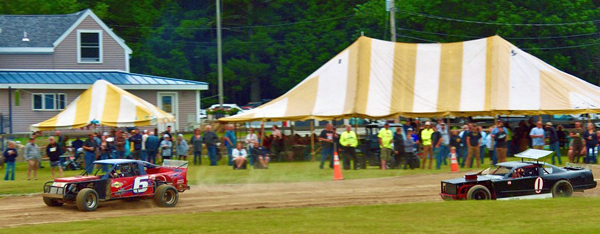 |
|
#3639 - There’s been a
recent rash of race track closings in
increasingly urban New England. One state, Rhode
Island, has not had an operating facility since
the once stately Lonsdale Sports Arena closed
after the 1956 hurricane. Neighboring
Massachusetts has just one, Seekonk Speedway.
But of late, an enterprising farmer from Rhode
Island named Ed Marceau has made a major move to
arouse the latent enthusiasm of the area's
racing community. He carved out a small oval on
his land in Chepachet named Barnyard Raceway.
Then on June 29, he held a racers' reunion with
exhibition runs and all kinds of attractions.
Overwhelmed with both cars and fans, Ed is
already planning next summer's event. With no
guard rails and grandstands in place, it could
be a while before the 410 sprinters come to
town, but the spark is appreciated by all. (Ed
Marceau Photo) |
|
m |
|
 |
|
#3638 - "October of 1981;
Charlotte: Gary Balough won an intense 300-mile
Late Model Sportsman race - "Maybe the biggest
win of my career. The two guys I battled with
the hardest were Dale Earnhardt and Jody Ridley.
We went at it like it was the last race we would
ever run....I got ping-ponged all over the
track. It almost felt like Jody and Dale had
teamed up against me, except they are both so
independent they’d never have been able to agree
on something like that." Quote from HOT
SHOE: A Checkered Past - My Story, by Gary
Balough with Bones Bourcier. [credit] |
|
m |
|
 |
#3637 - "Elfrieda Mais,
shown here in a bobtail, was a well-known and
obviously capable driver who graced promotions
from Alabama to Massachusetts to Montana and
Canada. She started her career in 1910 and won
her title as 'World's Fastest Woman' in 1915.
Among her accomplishments was defeating Louis
Disbrow in a match race in Toronto in 1924. She
was killed at Birmingham, Alabama, in 1934 when
a flaming wall stunt, complete with dynamite,
went awry.” Quote from DIRT TRACK AUTO
RACING 1919-1941, by Don Radbruch.
|
|
m |
|
 |
|
#3636 - "Lenny Boehler
changing a spring on his #3 Modified at the 1990
Spring Sizzler at Stafford Springs, CT. It may
or may not have been the exact spring he told
driver Doug Heveron he was putting on." From
THE SOUL OF A MODIFIED: Lenny Boehler's Ole Blue,
by Lew Boyd. (New England Racing Museum
Collection) |
|
m |
|
 |
|
#3635 - In the 1965 Formula
1 season, in which only a driver's six best
finishes counted, Jimmy Clark (5) came to Mexico
having won six of the first seven races and long
since clinched the title. The exception was
Monaco which he skipped to win the Indy 500.
Rookie sensation Jackie Stewart said, “Three
times that first year I finished second to Jim
Clark. That was an enormous achievement for me,
for two Scotsmen to be on the podium, and there
were all the jokes going around that it was
Batman and Robin - and there was no doubt who
was Robin." From
F1 MAVERICKS: The Men and Machines that
Revolutionized Formula 1 Racing, by
Pete Biro and George Levy. |
|
mm |
mm |
 |
#3634 - Switching from a
roadster to a rear-engine car dressed in Lotus
green but sporting J.C. Agajanian's trademark
98, Parnelli Jones romped to victory at
Milwaukee in August of '64. He broke the track
record in qualifying and lapped the field twice.
From
AS A MATTER OF FACT, I AM PARNELLI JONES,
by Bones Bourcier. (Harry Goode Photo, Gene
Crucean Collection)
|
|
m |
|
 |
|
#3633 - Alex Friesen, the
young and dynamic promoter of New York's
Utica-Rome Speedway back in 1996, dabbled with a
Sportsman car and he had the goods. He won on
September 1 but promptly disqualified himself to
avoid any sense of favoritism. When he died on a
snowmobile that December 5, the entire racing
community mourned. From
THE HOME OF HEROES: 50 Years of Racing at
Utica-Rome Speedway, by Bones Bourcier.
(Don Edds Photo) |
|
mmm |
|
 |
#3632 - Back in 1987,
two-time National USAC Midget champ Kevin Olson
won a thrilling duel at Springfield, IL, his
first victory on a mile. He recalled, "It meant
so much to me. I had just passed Rich Vogler. I
was trying really hard to keep my car straight.
You can see how Rich and Terry Wente are a
little sideways. That's how I could pull away
from them." Quote from
CAGES ARE FOR MONKEYS: Unleashed with Kevin
Olson, Racing’s Zaniest Hall of Famer,
by Kevin Olson with Lew Boyd. (John Mahoney
Photo)
|
|
n |
|
 |
|
#3631 - Al Unser Jr. # 3,
shown here leading the eventual winner, former
Formula 1 Driving Champion Englishman Nigel
Mansell at the Milwaukee Mile during the running
of the CART-sanctioned 1993 Miller Genuine Draft
200. Nigel had qualified for the fourth row with
a speed of 160.414, compared to Al Unser Jr.'s
152.292, back in row nine. This was Nigel's
second of the season and
first win on an oval; he would
go on to win three
more races that year, earning him the National
Championship and Rookie of the Year honors.
Because the F1 title for 1993 had not yet been
decided in Alain Prost's favor, Mansell had the
unique feat of holding both the F1 World
Champion title and Indy Car champion title
simultaneously. (Photo and Caption by Don Figler) |
|
m |
|
 |
#3630 - When the Midgets
pulled into New Hampshire's Monadnock Speedway
on 7/20/24, NEMA star Avery Stoehr brought his A
Team with him. Son Keegan and daughter Noa
dialed him right in, and he hustled to a strong
runner-up finish. (Photo from our friend John
DaDalt)
|
|
mm |
|
 |
#3628 - A pensive Bill
Vukovich waits to go out to practice at Indy in
1953. Time would tell he had little to worry
about. True, race day was one of the hottest
500s ever, with track temperatures spiking above
130 degrees, but he set fast time driving in the
pouring rain and led all but five laps to win
it. Photo from
THE ILLUSTRATED HISTORY OF THE INDIANAPOLIS 500,
1911-1994, by Jack C. Fox.
|
|
m |
|
 |
|
#3628 - "Things weren't
always great. I’m burning up the track at
Lernerville - literally - in 1980." Quote and
Photo from
STILL WIDE OPEN, by Brad Doty with Dave
Argabright. (Orren Zook Photo) |
|
m |
|
 |
#3627 -
That's the inventive Jim Hall talking with
reigning Formula 1 champion Jackie Stewart at
Watkins Glen in 1970. Hill had persuaded Stewart
to drive his radical new vacuum Chapparal. The
adventure only lasted a few laps with multiple
engine and brake problems, but along the way
Stewart posted the fastest lap of the race -
with a full load of fuel. Afterwards, Stewart
expressed his enthusiasm for the car: "There
aren't race cars you can get high on these
days." The car was banned by the end of the
season. Photo and Quote from George Levy's
extraordinary new book
TEXAS LEGEND: Jim Hall and His Chaparrals,
by George Levy. Getty Images)
|
|
m |
|
 |
|
#3626 - "According to the
newspaper that ran this photo, there was a
14-year-old in the cockpit for nearly 20
seconds. Some observers say he froze in fear, as
one would expect from a youngster; his family
contended he was pinned by the steering wheel.
However, an adult stopped his car and pulled the
boy out. There were only minor burns on both,
but you need to think about the value of
maturity and quick thinking at times like this."
From
STILL RACING, by Ken Schrader with
Joyce Standridge |
|
m |
|
 |
#3625 - Little question why
Tommy Ivo was nicknamed "TV Tommy." From
THE AMERICAN SPEED SHOP: Birth and Evolution of
Hot Rodding, by Bob McClurg. (Tommy Ivo
Collection)
|
|
m |
|
 |
#3624 - Track roadsters
piled onto the paved half-mile of Portland (OR)
Speedway after the war in 1946. The hot dog was
Frankie McGowan, shown aboard George "Pop"
Koch's high-altitude flyweight powered by a V-12
Lincoln. From Portland Speedway, by
Jeff Zurschmeide. (Koch Collection)
|
|
m |
|
 |
 |
|
#3623
- Top: “My grandfather, Ralph Earnhardt,
lived by this motto 'Go or blow.'" (Don
Hunter/Smyle Media) Bottom:
"Third-generation racers; me, my brother, Kerry,
and my sister, Kelly in 1994.” (Earnhardt Family
Collection) From
RACING TO THE FINISH: My Story, by Dale
Earnhardt Jr. |
|
m |
|
 |
#3622 -
It was Du Quoin on October 10, 1948, and
pre-race a number of competitors gathered on the
front stretch to discuss the wisdom of
magnafluxing spindles. Someone asked Ted Horn if
he had done so recently. "No, I haven't. Not
since spring, but I have new ones on order... I
figured these would last another race or two."
The field was soon off for the feature. Then,
coming off turn 2, "DUST – although the track
was hard and damp – MORE DUST AND A CAR IN THE
AIR. It's white with a blue tail – it's Horn....
He lay there where his car Beauty had tossed
him. Three feet from the outside rail, lying on
his back… One boot was off, but there were no
cuts or abrasions… On his chest were the words
'Ted Horn – National Champion 1946-1947.'" From
THE LIFE OF TED HORN: American Racing Champion,
by Russ Catlin. (Originally published 1949;
reprinted 2024)
|
|
m |
|
 |
#3621
- Parker Bohn was restless
in 1959 and 1960, driving 11 different
cars those seasons at New Jersey's
Old Bridge Stadium alone. Then in 1960,
he was approached by a rather reserved
car owner, Tom Skinner, with a black and
white coupe. Not much about the car was
ordinary, especially the engine. The GMC
six would whine distinctively at a high
pitch down the chutes. Skinner had spent
countless hours forming molds for the
head and injectors. Everything was
gear-driven except the fan, which
required a belt, part number 659. The
first year they were runners-up in the
New Jersey State Sportsman Championship
and went on to win five titles at Wall
Stadium. From
PAVED TRACK DIRT TRACK: Racing at Old
Bridge Stadium and Nazareth Raceway,
by Lew Boyd. (Danny Rhein Photo
|
|
m |
|
 |
|
#3620 - In February of 1971 upstate New
York Modified stalwart Maynard Troyer raced to
an impressive eighth in his 125 qualifier at
Daytona in a Ford owned by Nagle Ford in
Rochester. In Sunday's 500 it was a different
story. After starting 18th, he ran well until
coming off turn 2 when he started flipping – 18
or 19 times at an estimated 176 mph. He was
taken to Halifax Hospital unconscious, but was
released the next day. Dave Nagle acquired a
new car, and Maynard entered nine more Cup
races, a fourth at Michigan being his best
finish. At season’s end Dave Nagle sold the car
to Gene DeWitt, and Richie Evans used it
occasionally in LMS events. From GATER Racing
News 1979 Auto Racing Yearbook. (Daytona
International Speedway Photo) |
|
m |
|
 |
|
#3619 - Did anything ever
bother Jim Hurtubise? Doubtful, if you consider
what went down on the high banks of Dayton
Speedway in July of 1960. Don Branson had just
set a new half-mile world record of 105 mph.
"Jim wasn’t as fortunate in his qualifying run.
On his first lap the car bottomed out and he
lost control. Looping into a half spin, the car
slid toward the metal guard rail at an alarming
rate. Whomping into the fence, the rear end of
the car bound into the air, hurdled backwards
over the rail, and began a thirty-five foot
plunge to the ground below. An eerie silence
permeated the grounds, as everyone there was
certain the crash had been fatal... After what
seemed like an eternity of waiting, a roar went
up from the crowd as 'Hercules' was spotted
climbing the embankment, a big grin on his face,
waving to the fans. Tom Hoffman, of the
well-known Cincinnati Hoffman racing
family...dashed toward the scene just as Jim
stuck his crew cut head over the guard rail.
'Heh, heh, heh!' came the distinctive Hurtubise
laugh. 'How’d you like that, Tom?'" From
HERK Hurtubise, by Bob Gates. (Hurtubise
Family Collection) |
|
m |
|
 |
|
#3618 - Bill Schindler was
unquestionably among the most proficient and
popular of all the early East Coast
open-wheelers, but his journey was star-crossed.
On September 26, 1936 he crashed through a fence
at Mineola, NY, hitting a tree. His Sprinter
flipped, rebounded back on the track and was
struck by two more cars. The impact threw him
clear, but several large splinters from the
guard rail pierced his left leg. Three days
later gangrene set in, and the leg had to be
amputated. He continued racing and won
prodigiously after the War before dying at
Allentown, PA, after crashing through a fence
once again and tumbling down an embankment.
Photo from EARLY SPEED KINGS, by Gerald
Hodges. (New England Tractor Company Collection) |
|
m |
|
 |
|
#3617 - Ray Evernham had
always liked those Chevy coaches, and when he
built "the Ghost" in 2017 after leaving NASCAR,
he considered it his "best effort in race car
design." How cool that he decided to test it
himself during the perilous Pikes Peak climb;
despite encountering a snow squall near the top,
he won the Exhibition Class. From:
RAY EVERNHAM: Trophies and Scars, by
Ray Evernham with Joe Garner. (Ray Evernham
Enterprises Archive Photo) |
|
m |
|
 |
|
#3616 - In his inspirational
book about life on the autism spectrum, Aaron
Likens describes trying to find a job outside of
his weekend activities as a flagger with a
karting group. He applied for a full-time
position at a new indoor kart track in St.
Louis, only to be told he was exceptionally
qualified but all they could give him was a
corner position at minimum wage. "I wondered if
it would be easier to just accept what I thought
was my fate, give up racing, and live in my
father's basement for the rest of time." He
decided to keep pushing. Today he is the chief
starter of the Indy 500 and has been referred to
as the "best flagman in the world." Quote and
Photo from
PLAYING IN TRAFFIC, by Aaron Likens.
(Likens Family Photo) |
|
m |
|
 |
#3615 -
The NDRA and its good-timing promoter Robert
Smawley were really something. On September 24,
1982, the gang pulled into Rocky Mount, VA, for
the Schlitz Super 100 at Log Cabin Raceway.
Buddy Duke was in the main ticket booth. He
recalls, "Fans (13,756 strong) were actually
throwing money as they rushed by, and I was
standing up to my knees in it. Robert’s staff
would come by every few minutes and put it all
in pillow cases." The purse of $106,620 was a
record for the time, and one happy
twenty-year-old named Donnie Moran waltzed away
from Victory Lane with $35,000 of it. From
THE ROCK-EM,
SOCK-EM, TRAVELIN’ SIDEWAYS DIRT SHOW: A History
of Robert Smawley’s NDRA,
by Gary L. Parker. (Robert Smawley Collection)
|
|
m |
|
 |
|
#3614 - "Kevin Cogan got a
big break in 1982 when he was hired by Roger
Penske to replace the retiring Bobby Unser. He
began the year well, taking third behind
teammate Mears at Phoenix in March. But it all
went wrong when Cogan got sideways at the start
at Indy and crashed into Mario Andretti causing
an infamous incident. It was a cloud he never
seemed to shake." From
SECOND TO ONE: All But for Indy, by Joe
Freeman and Gordon Kirby. |
|
m |
|
 |
|
#3613 - It was March 30,
1980, the Williams Grove opener, and Lynn Paxton
had the 'flu. But he also had a new Lloyd
sprinter with a Davey Brown big block. Here he's
shown powering by Keith Kauffman in the Weikert
#29 to the win. From
LYNN PAXTON: My Way, by Don Robinson.
(Paxton Family Collection) |
|
m |
|
 |
|
#3612 - In October of 1964
the incomparable Ken Miles led Ronnie Bucknum
and Richie Ginther out of Riverside's Turn 6
during the Los Angeles Times Grand Prix, once
considered one of the greatest sports car races
in the world. From
KEN MILES: The Shelby American Years,
by David Friedman. |
|
m |
|
 |
|
#3611 - Playing to the
photographers, Dario Franchitti and Paul Tracy
clowned around with fists up when they were
teammates for Barry Green's TEAM COOL GREEN for
a couple of seasons around year 2000. Sometimes
it wasn't play. Franchitti recalls, " we crashed
together with Paul a number of times. PT and I
kept score and we crashed together six times.
Three of them were Paul's fault and three were
mine. Both of us got a few 'Got a minute'
moments with Barry. The biggest of those was in
Chicago. Paul and I crashed, and unfortunately
for us Nick Brooks was there. He was the big
boss of British American Tobacco at that point,
and he told Barry to sort us out or find someone
else to drive for him." From
THE GREEN FLAG: Just a Bloke's Story,
by Barry Green with Gordon Kirby |
|
m |
|
 |
|
#3610 - Can you imagine the
complexity of running NASCAR Cup races on
foreign soil - like in Japan? That's what NASCAR
did in the mid-nineties, running four events on
two tracks owned by Honda. Mix all the logistics
of getting the show and all its players and kit
over, the language difficulties, international
business issues - and politics. NASCAR's VP,
Californian Ken Clapp, did much of the
organizational work, crossing the Pacific on 17
different occasions. Here Ken (second from
right), along with US Ambassador Walter Mondale
and his wife Joan where the two held the podium
for an hour talking up the race and the strong
relationship between our very different
countries. Photo from
SEA TO SHINING SEA: Racing from the Wild West to
Daytona, by Ken Clapp with Bones
Bourcier. |
|
m |
|
 |
#3609 - "Deaf people can do
anything," Kitty Lynn O'Neil once told reporters
and proved it repeatedly over the years. The
highlight came in 1976 when the five-foot-three
inch, 97-pound half-Cherokee, half-Irish deaf
gal out of Corpus Christi, Texas, drove a rocket
car at Bonneville that used hydrogen peroxide
the way Niagara Falls uses water. Tempered by
adversity and for no monetary reward, she easily
erased Lee Breedlove's 310 mark while restricted
to sixty percent of the available throttle.
Quote and Photo from
BONNEVILLE'S WOMEN OF LAND SPEED RACING,
by Louise Ann Noeth. (Photo
Courtesy George
Callaway) |
|
m |
|
 |
|
#3608 - "Randy Bethea didn't
set out to be a pioneer; he just wanted to race.
But along the way, the man his competitors named
'Snowball' helped desegregate a lily-white
Southern sport in the turbulent 1960s and '70s.
Bethea was the first and possibly only African
American to compete in the old NASCAR Late Model
Sportsman division. His only outing in 1968
produced one of the few examples of overt racism
he can recall. "I went to Rogersville on July 4.
When I got to the track and asked someone where
to draw for positions, the guy wanted to know
who was driving the car. He said, "We’ve already
drawn for you." So I asked where I started, and
he said 'last.'" From A
HISTORY OF EAST TENNESSEE AUTO RACING,
by David McGee. (Roy Taylor Photo) |
|
m |
|
 |
|
#3607 - On July 14, 1956,
Pee Wee Jones outran a field of 20 in NASCAR's
Short Track Race #25, at an average speed of
46.83 before an enormous crowd at Winston-Salem.
He was aboard this Corvette. Check out the
curious roll-over protection—a lonely bar
secured by four bolts. Photo from
SHORT TRACK SHOOT-OUTS: Grand National Short
Track Circuit 1951-1959, by Greg
Fielden. (David R. Bartush Collection) |
|
m |
|
 |
|
#3606 - Bobby Brack took an
untenable off-course excursion during the 1971
Grand American Series Citrus 250 at Daytona. The
Florida-based, short-track master gathered it
back up to place eighth in the 44-car field, a
slot above Richard Childress. From
UNDENIABLY UNWANTED: Grand Touring and GN East
1968-1973, by Greg Fielden. (Dozier
Mobley Photo) |
|
m |
|
 |
|
#3605 - Artist David Carl
Peters did this remarkable rendition of the 1972
Ramchargers' Demon Funny Car in burn-out mode.
The next year they achieved the sport’s first
230mph run. From
WE WERE THE RAMCHARGERS: Inside Drag Racing’s
Legendary Team, Second Edition, by Dave
Rockwell. |
|
m |
|
 |
|
#3604 - Several years back
Parnelli Jones came cross country to New
Hampshire Motor Speedway to try out an East
Coast modified built by his buddy and former
crew chief, Jimmy Dilamarter. There he
encountered some of New England's remarkable
characters, such as supermodified stalwart Eddie
West. Hope Parnelli was ready for the "Golden
Bear." (Photo – Karl Fredrickson)
|
|
m |
|
 |
|
#3603 - Former starring
roadster era champion, Bakersfield's Rose
Roussel was in the thick of things at Ascot in
the 1950s and '60s, shown here with one of J.C.
Agajanian's numerous guests. Rosie had quite the
sense of humor. Using one eye, he had it
replaced with a protheses with crossed checkered
flags. It was his "tuxedo eye." From
ASCOT: Where the Harbor, the San Diego, and the
91 Freeways Collide, by Dave Wolin.
|
|
m |
|
 |
|
#3602 - "Nothing could keep
Gene Nolen out of victory lane in 2019. Having
acquired the services of four time (Silver
Crown) champ Kody Swanson for the season meant
the rest of the team would have to step up and
they did. Swanson won his fifth Silver Crown
Driver's Championship and Nolen just missed the
owner's crown.” From ROLLING THUNDER,
by Bob Mays, Richie Murray, Patrick Sullivan,
John Mahoney. (John Mahoney Photo) |
|
m |
|
 |
#3601 - How about the do on
Evernham - and that 'stash! From
LEGENDARY RACES, PLACES, AND FACES:
Photos From the Lens of Lenny H. Sammons.
|
|
m |
|
 |
|
#3600 - "...around Wisconsin
and the Midwest we were still using the bread
truck. It was comfortable for what it
was...There was a helluva lot of partying that
went on in the back of that truck. On 1987 I got
a 'big' sponsorship deal from Miller Beer. It
was through a distributor in Milwaukee and the
deal was for $4500 for the whole year. Man, that
was nothing, but it did come with all the beer
we could load into the bread truck. I think we
drove over to Milwaukee three times that season
and packed it with at least three hundred cases
of beer each time. Needless to say, the bread
truck was always a popular place to be after the
races." From BARNYARD TO BRICKYARD: The Rich
Bickle Story, by Rich Bickle with John
Close. (John Close Photo) |
|
m |
|
 |
|
#3599 - "Tommy Ivo’s Video
Liner rode on an RCS chassis and was designed by
Tommy and Steve Swaja. The Video Liner ran right
around 200mph in the high sevens but was
aerodynamically wrong. As Ivo described, 'It was
like we were running a teardrop backwards, and
it wanted to turn around in the lights.' Ivo
abandoned the car in short order and RCS had him
a new car six days later.” From
DRAG RACING IN THE SIXTIES, by Doug
Boyce. (Forrest Bond Photo) |
|
m |
|
 |
|
#3598 - Joining in on Chase
Elliott's 2013 Pocono ARCA win was his dad Bill.
It was early in Chase's career. Looks like he
had to pin on a few series sponsors for the
victory lane photos. (Mike Feltenberger Photo) |
|
m |
|
 |
|
#3597 - "Herschel McGriff (Oregon)
and Frankie Schneider (New Jersey) running
side-by-side for the lead before a packed house
at Baltimore's Westport Stadium in August of
1954. The Jags were the only two foreign entries
in the race, both owned by promoter Ed
Otto. McGriff became the first driver to win in
a foreign car in the Short Track Division."
Photo and Caption from
SHORT TRACK SHOOT-OUTS, Grand National Short
Track Circuit 1951-1959, by Greg
Fielden. (Greg Fielden Collection)
|
|
m |
|
 |
|
#3596 - Here was Tiny Lund at
Augusta International Raceway on September 14,
1968. He was red hot on NASCAR's Grand Touring
races and sure seemed to enjoy winning them. Do
you think he could have had an eye for NASCAR
Victory Lane receptionist Winky Louise? From
UNDENIABLY UNWANTED: Grand Touring and GN East
1968-1973, by Greg Fielden. (Don Hunter
Photo)
|
|
m |
|
 |
#3595 -
Art Pollard aboard the Ken's
Martinizing Special at Meridian
Speedway, Boise, Idaho. In 1961 he
started 28 features and, remarkably, won
22 of them. He had one second and
the others fell to various mechanical
failures. The biggest romp came in
Fresno, California where he dominated
the two day Kearney Bowl. From
EARLY
SUPERMODIFIEDS,
by Gerald Hodges. (Clyde Sullivan Photo)
|
|
m |
|
 |
|
#3594 - "Afternoon
congestion. The Target Chip Ganassi team drivers
of #12 Kenny Brack and #4 Bruno Junqueia lead
the CART FedEx Championship series drivers
aboard their Toyota-powered Lolas into the first
turn at the start of the 2002 Grand Prix of
Monterey at the Mazda Raceway Laguna Seca 300
mile race, which was won by Cristino de Matta of
the Newman/Haas Team." Photo and Caption by our
friend Don Figler. |
|
m |
|
 |
|
#3593 - "....the last race
Steve (Kinser) ever ran was an All Star Show at
Lebanon Valley, NY, in the summer of 2016....It
wasn't until I was back at our pit later, after
all the victory lane stuff that someone said,
'You heard Steve quit, didn’t you?'... I might
have said something, or patted him on the back,
or shook his hand. But I really don’t know for
sure. It's strange; we’re two different people
and we've never been friends, yet each of us has
been a big part of the other one's life." Shane
Carson called in this background to this photo:
“That’s a great shot from Oklahoma City
Fairgrounds, an afternoon show put on by Mar-Car
company. From
SAMMY! Fifty Years of Winning, by Bones
Bourcier with Bob Mays. (Joe Orth Photo) |
|
a |
|
 |
|
#3592 - "Gary Bettenhausen
being towed to the pits after leading the
500.... He had completed 183 laps of the 1972
Indianapolis 500 and broke all existing records
along the way. As one spectator was leaving the
track after Donohue's victory, he said in a
Kentucky hills accent; "It's too bad about that
Bettenhausen. He done had 'er won today. Why I
saw him drive right past that Donahue character.
But the best jockey in the world kaint win if
his horse dies.” From GO! THE BETTENHAUSEN
STORY, by Carl Hungness. (John Mahoney
Photo) |
|
m |
|
 |
|
#3591 - "After an on-track
dustup at Kansas Speedway late in the 2015
season, the usually mild-mannered Matt Kenseth
waited until a crucial moment two races later to
exact revenge on Joey Logano. As Logano was
trying for his fourth consecutive victory and
leading on lap 453 of 500 at Martinsville
Speedway, Kenseth plowed into him and took him
out of both the lead and the race. The incident
slowed Logano's momentum in the championship
chase which Kyle Busch eventually won." Photo
and Caption from
NASCAR 75 YEARS, by Kelly Crandall,
Jimmy Creed, Mike Hembree, Al Pearce. |
|
m |
|
 |
|
#3590 - "Warming up for the
1961 International 150 at Portsmouth, Ohio, are
four bad-to-the-bone-hombres with the big $1000
prize in mind. Out front is Gordon Johncock, who
went on to two Indy 500 victories. Alongside is
another Michigan ace, Nelson 'Nellie' Ward and
the 'Bingo 5.' Close behind are local legends
Wayne McGuire and Paul Spencer (in a former
Bingo 5)." Photo and Caption from
ECHOES OF THUNDER IN THE HILLS: Auto
Racing in Southwestern Ohio and Adjoining West
Virginia, by Tony Martin. |
|
m |
|
 |
|
#3589 -
Lance Reventlow, son of Woolworth heiress
Barbara Hutton, contemplates his newly completed
Scarab formula 1 In 1959. He had intended to
take on the world of Grand Prix competition, but
overweight and underpowered, the car proved a
disaster. From
SUNSHINE, SPEED, and A Surprise, The 1959 Grand
Prix of the United States, by Joel E.
Finn. |
|
m |
|
 |
|
#3588 - Saturday, May 31, 2024 marked
the day that Bones Bourcier, one of America's
best motorsports writers, was inducted into the
National Sprint Car Hall of Fame. We celebrated
with him and his wife, Dori, proud to have
published 11 of his titles – and counting!
|
|
m |
|
 |
|
#3587 - A dusty summer somewhere in New
York, sometime in the 1950s, and the lead dog of
the era, Steve Danish in his #61 Chevrolet, was
on the move. (Frank Simek Photo) |
|
m |
|
 |
|
#3586 - June 2003,
Indianapolis Motor Speedway was the scene of
NASCAR Winston Cup champion Jeff Gordon and
Formula One driver Juan Montoya participating in
the one-time only "Trading Paint." Both drivers
got the chance to drive each other's race car,
very much to Jeff's delight. Each driver
completed eight laps around the Indy road
course. At the press conference after the event
Juan Montoya was explaining how big the steering
wheel seems to be in Jeff's Monte Carlo compared
to his BMW-powered racer. Photo and caption from
our pal Don Figler. |
|
m |
|
 |
|
#3585 - Amiable,
unpretentious, and sometimes at the edge of
understated, Len Sutton was nonetheless a huge
star in track roadsters in the upper West Coast
before going Champ Car racing in 1955. Very
focused on Indy, his best day came in 1962 when
he was close runner-up to Rodger Ward. Somewhat
unusually but certainly understandably, after
the horrible frontstretch fire in 1964, followed
by Mel Kenyan's burns at Langhorne the next
year, Sutton walked away from the wheel. He was
about to reach 40, and after 20 years in the
cockpit, it was time to concentrate on his wife,
Anita, and his two growing daughters. Photo from
SECOND TO ONE: All but for Indy, by Joe
Freeman and Gordon Kirby |
|
m |
|
 |
|
#3584 - "Aaron's unique
point-and-freeze at the end of an Indy 500
qualifying run has become his 'signature' in the
eyes of many fans." From Coastal 181’s latest
book,
Playing in Traffic: My Journey from an Autism
Diagnosis to the Indy 500 Flagstand, by
Aaron Likens with Bones Bourcier. (Likens Family
Collection) |
|
m |
|
 |
|
#3583 - Hershel McGriff, the
perpetually teenaged ironman, shown at Portland
(Oregon) Speedway. He had raced there in 1946,
the first show after the war. He went on to star
in NASCAR, the Mexican Road Race, the 24 Hours
of Le Mans - and any other available
competition, and just kept going. Still busily
racing in 2000, he was back in Portland for its
final race on asphalt shortly before it closed.
His own last outing came in NASCAR Pro Series
West at Tucson, Arizona in 2018 at age 90. From
PORTLAND SPEEDWAY, by Jeff Zurschmeide.
(Jerry Boone Photo) |
|
m |
|
 |
|
#3582 - "In the fall of
1977, Dick Tobias and Davey Brown sat down and
began working on a design for a new Sprint
Car...When the prototype came out of the shop,
Toby was thrilled with it. His pride was almost
a little uncharacteristic. He announced he was
going on the road to show it off. After the New
Year, Toby and Davey packed up and headed to
Florida. Their new little blue and yellow number
went like the wind. Toby won two in open
competition combat [at East Bay] and was joined
on the podium with the likes of Doug Wolfgang
and Tom Corbin. Much encouraged, when spring
followed, they ventured west, to the heartland
and the epicenter of open wheel racing" - and
USAC. From
TOBY: The Star-crossed Story of an American
Racing Family, by Lew Boyd. (Tobias
Family Collection) |
|
m |
|
 |
|
#3581 - "Daddy's little
girl: Kyle Petty with Montgomery Lee at
Charlotte in 1987." Photo and caption from
SWERVE OR DIE: Life at My Speed in the First
Family of NASCAR Racing, by Kyle Petty
with Ellis Henican. (Charlotte Motor Speedway
Photo) |
|
m |
|
 |
|
#3580 - Good buds, Parnelli Jones and
Jim Hurtubise, who traveled the sprint car
circuit together hoping to get to the Brickyard.
Jones, who was a spectator at Indy in 1960 when
Hurtubise debuted as a rookie, recalls, "Jim set
a one-lap record of 149.601 mile per hour and a
four-lap average of 149.046, two miles an hour
faster than the pole speed set by Eddie Sachs.
It shocked the hell out of everyone. They
interviewed Herk when he came back to the pits,
and he told the crowd, 'If you think that was
fast, just wait 'til next year. There's a buddy
of mine named Parnelli Jones, and he'll really
give you something to talk about." From
As a Matter of Fact, I AM PARNELLI JONES,
by Parnelli Jones with Bones Bourcier. |
|
m |
|
 |
|
#3579 - "Before there were
templates to follow, there was ingenuity. Junior
Johnson, for example, built a Ford nicknamed the
‘Yellow Banana’ for Fred Lorenzen in 1966. With
its nose slanted downward, its roofline was
clearly altered, and its rear deck was higher
than the front. Nevertheless, it passed tech
inspection." From STOCK CAR RACING: The
High-Speed History of America's Premier
Motorsport, by Don Hunter and Al Pearce. |
|
m |
|
 |
 |
|
#3578 - Luckily some things
have changed. From USAC Official Competition
Rules 1978, Sprint Car Division |
|
m |
|
 |
|
#3577 - "The Master of Going Faster,"
"Barefoot" Bob McCreadie, who starred among that
often-warlike tribe of New York Modified
champions, passed away this week. A colorful
mixture of irreverence and funk though he was,
he was highly respected by competitors and fans
alike. Here's a photo he hung in his shop, a
clear indication of where he was coming from. In
the #12 was his good friend Jack Johnson on his
way to a last lap pass and a win way down in
Cowtown, Texas in 1989. Barefoot wrote on it
"When you think you dive hard, when you think
you’re trying hard, remember this picture and
hope he is not behind you." (McCreadie
Collection) |
|
m |
|
 |
|
#3576 - "The brand new
Corvette AA/FC out of Hyder's Garage was driven
by "Nitro" Nick Harmon, who was another victim
of the dreaded Corvette curse [in the early
1970s]. The first full pass on the new car
(shown at Orange County International Raceway)
was likely its last. After Harmon left off the
line, the clutch exploded, and the car made an
abrupt right into the guardrail that chucked off
the body. The body-less car continued bouncing
along the guardrail, tearing it up even more
before coming to a complete stop. Harmon was not
hurt, but the car was a total loss. Note the
damaged mounting studs of the bellhousing and
clutch can." From
EARLY FUNNY CARS 1964 - 1975, by
Lou Hart. |
|
m |
|
 |
#3575 - It's in the genes.
Back in the 1950s, a popular, gentlemanly
Northeastern racer named Jerry Dolliver cleaned
up whatever he raced, winning over 100 features
with one single flathead engine. His son Brian
was also an ultra-smoothie, seen especially in a
dirt Sportsman in the '90s. Now Brian's son,
"Mad Max," having worked his way through the
street stock ranks, motored to an impressive
victory in the 40-lap DIRT Series opener in the
#29 at New Hampshire's Bear Ridge Speedway.
(Alan Ward Photo)
|
|
m |
|
 |
 |
|
#3574 - During the running
of the 2002 Indianapolis 500-mile race, Greg Ray
lost control and hit the wall exiting the first
turn. The force of the impact tore the
transmission from the car; the transmission flew
across the track, over the guard rail and buried
itself in the creek bed in front of the
photographers. The second photo shows a track
official removing the transmission after the
race. (Caption and Photos by Don Figler) |
|
m |
|
 |
|
#3573 - July 32, 1949 - and
it was quite the day. It was the first time Indy
cars had ever appeared on a half-mile track, Roy
Richwine's Williams Grove Speedway. By all
reports the atmosphere was as festive as at the
Brickyard itself. The 50-lapper was taken by
Joltin' Johnny Mantz, followed by Duane Carter
and Rex Mays. Do you think they had a crowd?
Over 38,000. Photo from INDY CARS ON SHORT
TRACKS, by Buzz Rose and Joe Heisler.
(Frank Smith Photo) |
|
m |
|
 |
|
#3572 - On July 27, 2008
Doug Wolfgang was inducted into the Huset
Speedway Hall of Fame in South Dakota. He
decided to watch the 360 feature, and it was a
good thing he did. His sixteen-year-old son
Robby jumped out and won his first feature after
racing for only a couple of weeks. Photo from
WIN IT OR WEAR IT: All Time Great Sprint Car
Tales, by Joyce Standridge. (Doug Johnson
Photo) |
|
m |
|
 |
|
#3571 - The 1972 Daytona
started 40 cars and among the qualifiers was a
1972 Matador, owned by Roger Penske and driven
by Mark Donohue. Donohue's time as a front
runner was short lived as the American Motors
engine lasted just 18 laps with push rod
failure. Donohue was credited with a 35th-place
finish, earning $1375.00. Race winner A. J. Foyt
took home the $45,400.00 winner's payout. (Mike
Feltenberger Photo and Caption) |
|
m |
|
 |
#3570 - A grand man in a
grand car - Al Unser aboard the No. 3, Vel's
Parnelli Jones Silver Crown car. "The youngest
of the racing Unser brothers started the '69
season on a promising note when he signed as the
lead driver for the revamped Parnelli Jones/Vel
Miletich team in 1969. With famed mechanic
George Bignotti on board, the team began to gel
together in practice for the Indianapolis 500.
Al consistently posted fast speeds, but, while
celebrating his birthday on the eve of
qualifications and performing wheelies on the
Speedway's infield, he suffered a broken leg.
The doctor's prediction was that he would be out
of competition for at least four months.
Surprisingly Unser was driving a race car again
in two weeks. On September 1 he hit victory lane
in the Ted Horn Memorial at Du Quoin." Quote and
Photo from THAT MAGIC MILE: The National
Championship at Du Quoin 1948-1970, by
Thomas Nasti. (Jim Pursell Photo)
|
|
m |
|
 |
|
#3569 - Last Saturday night
(5/4/24) was the LOU LAZZARO Memorial at Fonda,
New York, honoring one of the greatest ever in a
Modified. Pictured are Melissa Lazarro, the late
Lou's daughter, and Ron Moshier who wrote the
Lou Lazzaro book for us. They’re holding the
Coastal 181 Cup to be presented to the race
winner. (George Biancosino Photo) |
|
m |
|
 |
#3568 - How curious. Tommy
Hinnershitz (in the Pfrommer Offy), the noted
high-groove hustler, was almost always upstairs.
But at Reading on April 17, 1960, he ran the low
groove. Could that have had something to do with
the guy in the #2 wearing the Bowes Seal Fast
uniform? That was A.J. Foyt. From
THE PFROMMER OFFY: A History of an Iconic Sprint
Car, by Alan F. Gross. (Bruce Craig
Photo, Courtesy Revs Institute)
|
|
m |
|
 |
|
#3567 - It was a long time
ago and a very long race. "In 1908 Henry Ford's
little Model T established itself as a
cross-country endurance racer when it competed
in and won the New York-to-Seattle race carrying
drivers Bert Scott and C. J. Smith across the
finish line to victory. Unfortunately, the team
was disqualified because they stopped to replace
a broken axle. Henry Ford nonetheless thought
well enough of their effort to be there to
congratulate them." Quote and Photo from
THE AMERICN SPEED SHOP, by Bob McClurg.
(Henry Ford Collection, Ford Motor Company) |
|
m |
|
 |
|
#3566 - "Ralph Quarterson
was a regular commuter from Hickory,
Pennsylvania come championship time at Atomic
[Speedway in Ohio.] He won his share and
everyone knew he was there in those he didn't.
Here Ralph celebrates his win in the 1968 Tri
State Championship with his beehive haired wife
standing by and future Sprint Car driver Tommy
in his lap." From
ECHOES OF THUNDER IN THE HILLS, by Tony
Martin. |
|
m |
|
 |
#3565 - Jimmy Owens'
Late Model, thoroughly rearranged, is loaded
after a savage crash at Knoxville in 2014.
"Jason Feger was the car that tagged me in the
corner and kept his foot in the gas. I don't
know what Jason was thinking when that happened;
years later I still can't figure it out. I
believe he intended to wreck me, but I don't
think he meant for the crash to be anywhere near
that violent. Sometimes you do things and
instantly realize 'Oops, that’s not how I
thought it would go.' I’ve done that a few times
myself ... We rolled out a backup car and forged
on, and on Saturday night ran 7th in the
championship feature. As far as me being dinged
up, it probably looked worse than it really was.
I was sore the next day, but that's about it.
Feger and I talked later, but not specifically
about the wreck. It is what it is, I reckon."
From
THE NEWPORT NIGHTMARE: Living the Dream
by Jimmy Owens, with Dave Argabright. (Rick
Schwallier Photo)
|
|
m |
|
 |
|
#3564 - The USAC Silver
Crown cars were a memorable part of Super DIRT
Week in the early years, with a return near the
series' end. The surface on Syracuse's "Moody
Mile" could be rock hard, not ordinarily
conducive to a cushion. But when conditions were
right and there was one, it was a show to
behold. From
LEGENDARY RACES, PLACES, and FACES:
Photos from the Lens of Lenny H. Sammons. |
|
m |
|
 |
|
#3563 - "Nineteen-year-old Lloyd Ruby
took Ord, Nebraska, and the Valley County Fair
by storm in 1947, sweeping the racing action in
the Chet Wilson Ford V8-60. Years later 'Rube'
became Ord's hometown hero as he became oh, so
close to winning the Indy 500 on several
occasions." From
NEBRASKA DIRT, A Century of Racing in the
Cornhusker State, by Bob Mays. (Donna
Wilson Collection) |
|
m |
|
 |
|
#3562 - "AJ Foyt manhandles
Howard Linne's Midget during the 1975 running of
the Hut Hundred, a premier event on the USAC
circuit. Although Foyt's Midget racing
activities were rare of late, he returned with a
vengeance, setting fast time in qualifications
and running with the leaders until his car gave
out. This was Foyt's final USAC Midget race."
Photo and Quote From FEARLESS: Dangerous
Days in American Open Wheel Racing, by Gene
Crucean. |
|
m |
|
 |
|
#3561 - It was pretty tough
sledding in the early seasons of the American
Racing Series. This was the start of their
launch in Phoenix in 1986, showing the entire
14-car field. The low point came at Mid-Ohio
that year with just 12 entries, four of which
wrecked before the first turn, leaving just
eight for the 100-lapper. The Series was
reinvigorated in 1991 under the mantle of the
Firestone Indy Lights, later to be recast as
IRL's Indy Pro Series. From
BOOST!: Roger Bailey's Extraordinary Motor
Racing Career, by Gordon Kirby. (Dennis
Torres Photo) |
|
m |
|
 |
|
#3560 - Whatever! "Tommy
McNeely's Fugitive wheel-stander was an
exhibition vehicle. It featured a rear-engine
layout with the headers sticking out of the rear
in cartoon fashion. McNeely is seated ahead of
the windshield, and his helmet is outside the
car." Quote and Photo from
QUARTER-MILE CORVETTES 1953-1975: The
History of Chevrolet’s Sports Car at the Drag
Strip, by Steve Holmes. (John Foster Jr. Photo) |
|
m |
|
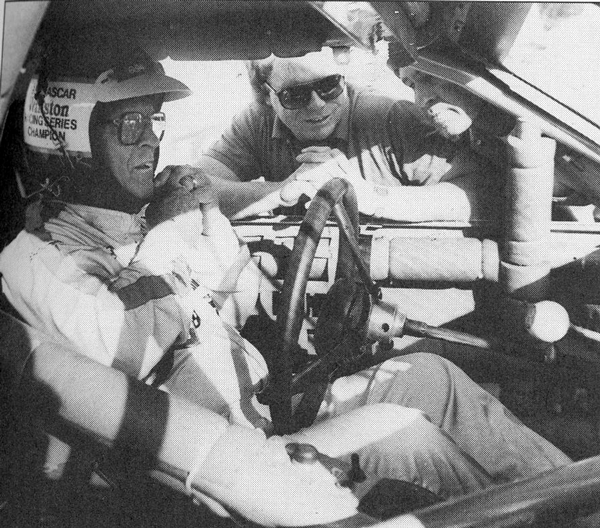 |
|
#3559 - "Ray Hendrick's last
race after 45 years behind the wheel. Ray is in
a Late Model owned by his son Roy in 1986. Not
only was Hendrick popular, but he was also a
sportsman as well. In 1961 at the Virginia State
Fairgrounds in Richmond, he came to the rescue
of fellow Richmond driver Emanuel Zervakis, who
had flipped his Modified on its side squarely in
front of the oncoming field. Without hesitation
Hendrick wheeled his car to a stop, using it as
a shield to protect the dazed Zervakis and his
car from further harm. For that heroic action
Hendrick received the 1961 Haughton
Sportsmanship Award." Quote from SOUTH
BOSTON: The First Fifty Years, (Roy
Chandler Photo) |
|
m |
|
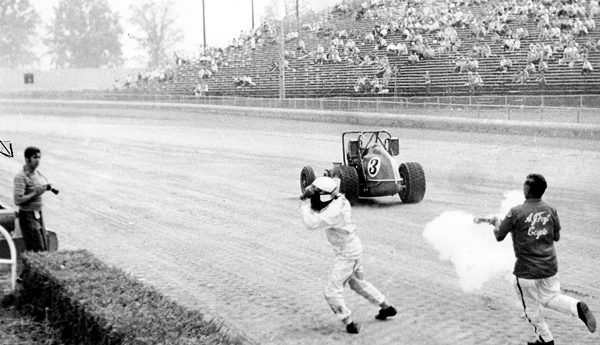 |
|
#3558 - Here's another view of an
incident we showed you in Photo of the Day
#2923. This shot, taken by Randy Crist,
shows A.J. Foyt's father at a Silver Crown show
at Du Quoin in 1972. A.J. had been leading, but
his car caught fire during a pit stop. That's
his father chasing A.J., fire extinguisher
blasting away. A.J., on fire about his head,
leapt from the vehicle but broke an ankle when
the car ran over it before continuing solo down
the track. Our friend and photographer Don
Figler saw the whole thing. He was standing
right there on the far left. |
|
m |
|
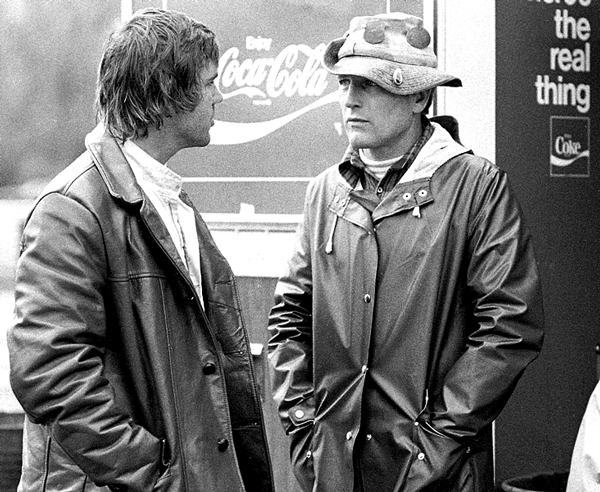 |
|
#3557 - Back in the day New
England had the ovals tracks well covered with
Modifieds, Late Models, Midgets, and Supers.
There was also some serious road racing, and
talented Paul Newman and Sam Posey brought depth
to the field, along with a side of glamor.
(Unknown Photographer) |
|
m |
|
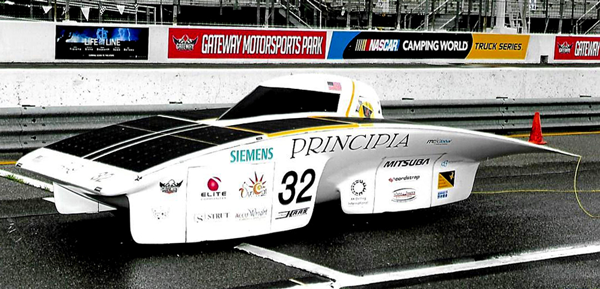 |
|
#3556 Pretty racy! "The 2016 American
Solar Challenge (ASC) was an intercollegiate
solar car race from July 30 to August 6, 2016.
This prestigious event featured university teams
from around the world, each designing and
building their own solar-powered cars. These
innovative vehicles embarked on a remarkable
1,975-mile road course that spanned seven
states, starting from Brecksville, Ohio, and
concluding in Hot Springs, South Dakota. The
University of Michigan won with a time of 48
hours, 26 minutes, 46 seconds. The Principia
entry shown here placed fifth with a time of 64
hours, 32 minutes, 04 seconds. There were 13
entries." Caption and Photo by Don Figler
|
|
m |
|
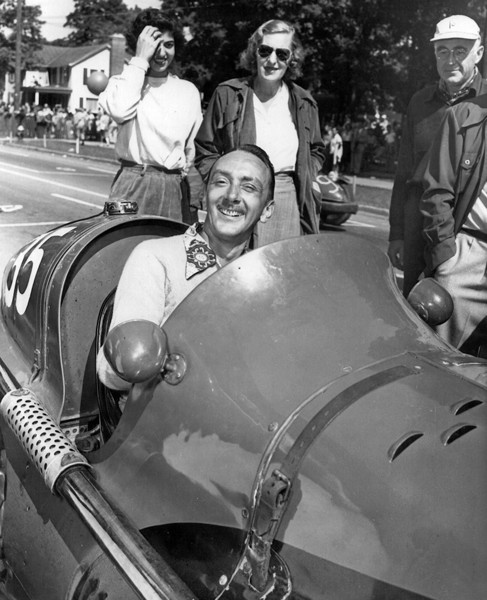 |
#3555 - George Weaver, a top
wheelman and gentleman, is shown in his Maserati
at the old challenging and dangerous street
course at Watkins Glen. It was Weaver's idea to
build a track exclusively for road racing right
aside the 5/8-mile oval at Thompson, CT. It
opened in 1952, the first in the country. Photo
from
A HISTORY OF RACING IN NEW ENGLAND – A
Project of the New England Racing Museum.
|
|
m |
|
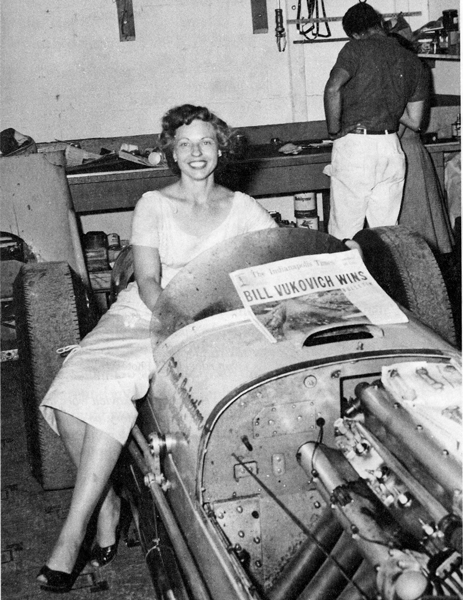 |
|
#3554 - That's Esther
Vukovich celebrating aside her husbands winning
car at Indy in 1954. She told the media, "I’ve
got a bull of a man, haven't I?" Bill almost
seemed to agree when he commented, "I've met
every piece of dust and every flying rock on the
hamburger trail from Fresno to San Diego. I know
every brand of oil just from the taste. Quotes
and photo from
VUKOVICH: The Man Who Wouldn’t Lift, by
Angelo Angelopoulos |
|
mm |
|
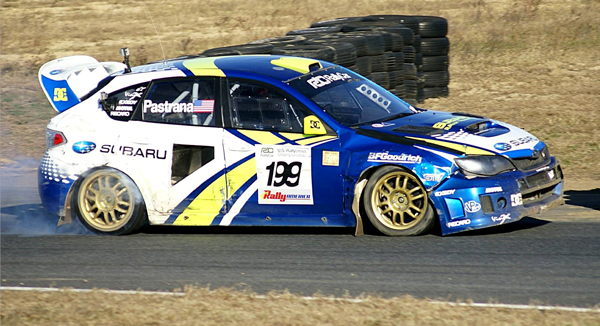 |
|
#3553 - Multi-talented wheelman Travis
Pastrana took to the New Jersey Motorsports Park
in 2010 for a Combo Surface Rally. Half of the
track was dirt and the other half was asphalt.
Travis was collected in an earlier incident that
resulted in a right-rear tire rub. Being the
competitor that he is, he continued to mash the
gas of his Subaru and soldiered on for a top-5
finish. After the event was over, he loaded up
his race car, pulled the rig to the fan parking
area and signed autographs for about an hour.
(Mike Feltenberger Photo) |
|
m |
|
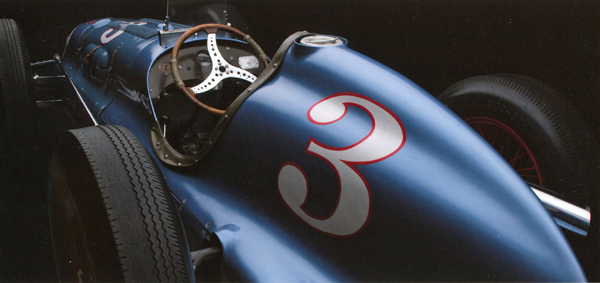 |
|
#3552 - Nope. It wasn’t something Lenny
Boehler kept hidden under a canvas in his garage
down near Cape Cod in Massachusetts. It's the
Deidt/Offenhauser that Mauri Rose wheeled to
victory at the Brickyard in 1947.
Photo from EPIC DRAMA: The Winning Collection
of the IMS Museum
|
|
m |
|
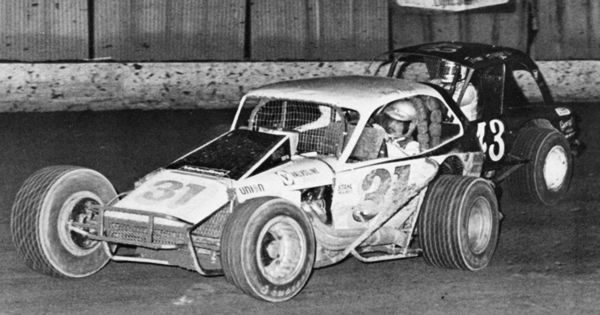 |
|
#3551 - Quite unusually and
sportingly, John Kozak began racing those unruly
1970s-era Modifieds at Reading, PA, Fairgrounds,
having never been out of the grandstands before.
Then, while beginning to crew for Kenny
Brightbill, he cobbled together a sedan of his
own. Four seasons later he bought Brightbill's
famous Pinto, renumbered it 31, and raced up in
the standings, winning the Kennedy Memorial in
'78 by defeating Brightbill. Between the two
drivers, the car won more than any other in
Reading history. (Photo from READING
FAIRGROUNDS MODIFIED MEMORIES, Vince Vicari
Editor.) |
|
m |
|
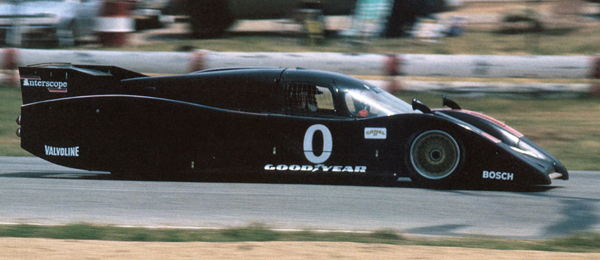 |
|
WD-3550
- Ted Field, with Bill Whittington
relieving, swept the six-hour Times/Toyota
Grand Prix of Endurance at California’s
Riverside Raceway on April 25, 1982. It was
a surprising finish, given the start. Right
at the green, John Paul Jr. gassed it,
scattering the lineup. Field took a enforced
detour through the gravel and had to pit to
remove some of it from his throttle linkage.
He rejoined the field a lap down just three
laps into the race, He sliced through the
field and won it in this amazing-looking
Lola. (Photo
from
RIVERSIDE RACEWAY: Palace of Speed,
by Dick Wallen. Frank Mormillo Photo)
|
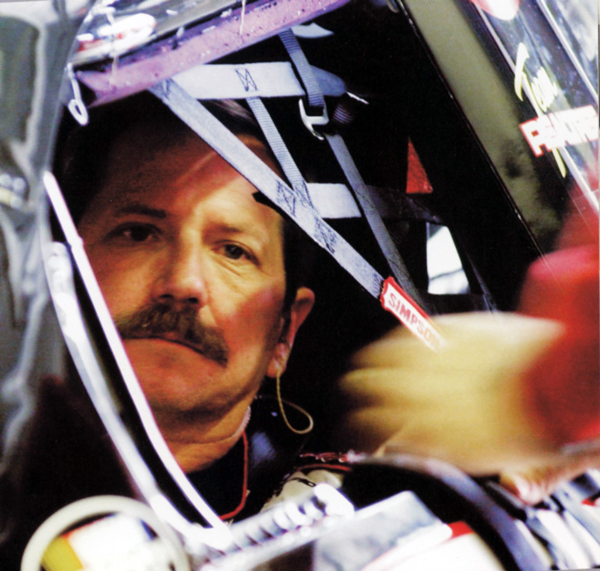 |
|
#3549 - Earnhardt was
Earnhardt personified at Charlotte on May 30,
1993. He was going to win and beware any
obstacles that might appear along the way. One
was Greg Sacks, who was suddenly redirected into
the wall, across the track, and into the
infield. Earnhardt's remarkable recollection
post-event was: "I was close, but I didn't hit
him. Maybe our bumpers touched, or I touched him
a bit, but it wasn't like I rammed the hell out
of him. I don't think I nudged him. (And then,
with a smile): I might've been a-gin him."
(Caption and Photo from DALE EARNHARDT: The
Pass in the Grass, The Charlotte Observer.) |
|
m |
|
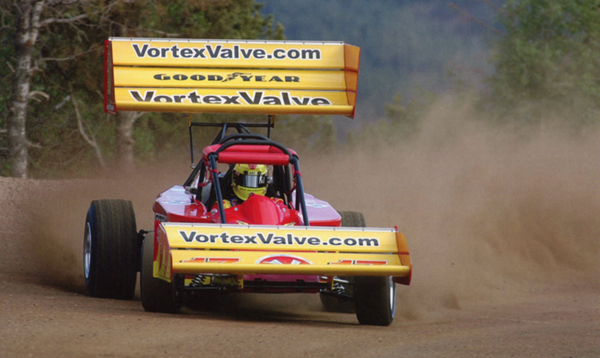 |
|
#3548 - Wally Dallenbach Jr.
left his home in Basalt, Colorado, after school
to embark on an successful, multidisciplined
professional career in motorsports. He
apparently liked going back home when he could.
Here he was looking very racy in a hill climb
car at Pike's Peak. (From
WALLY DALLENBACH: Steward of the Sport,
by Gordon Kirby.) |
|
m |
|
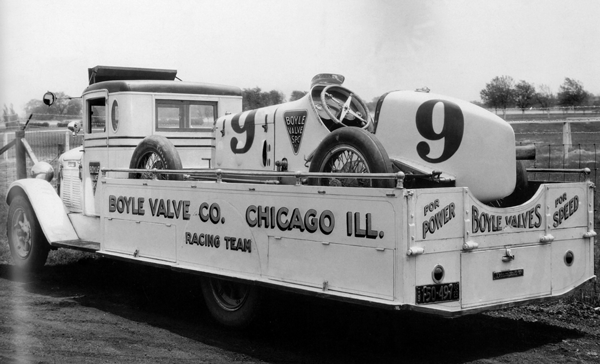 |
#3547 - Early Chicago racer
Cliff Woodbury was in the chips in the 1920s,
doing so well he landed the seat in the Boyle
Valve Special. The team was looking pretty
uptown when they pulled into Rockingham, New
Hampshire's scary board track in October of 1928
and dominated the show. But by the next year, it
was a different story. Woodbury started on the
pole of the Indy 500 but crashed out after just
three laps. On the 29th of October, 1929, the
whole country crashed. (From HARD DRIVING
MEN: Images of Speed 1895-1960, by Dick
Wallen. Dick Wallen Collection)
|
|
m |
|
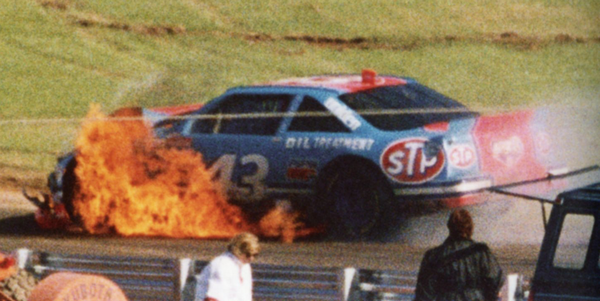 |
|
#3546 - Richard Petty's #43
Pontiac erupts in flames following a crash on
the 95th lap of the 1992 Hooters 500 in Atlanta.
The King of NASCAR was competing in his 1184th
and final NASCAR Winston Cup event. He got mixed
up in an accident while trying to miss several
spinning cars. "It broke the oil line and got on
the headers," explained Petty. "It caught fire.
I figured I better find me a fire truck, so I
drove around the track until I could find one."
Petty got back in the race and finished 39th in
a field of 41. (Caption and Photo from
NASCAR: The Complete History, by Greg
Fielden) |
|
m |
|
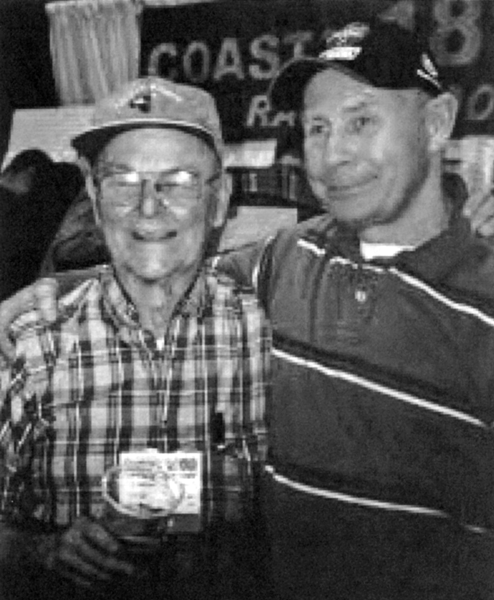 |
|
#3545 - Early in the 2000s, Doug
Wolfgang and aging Frankie Schnieder came to the
Coastal 181 booth at Lenny Sammons's Motorsports
Show to sign books and were pleased to meet one
another. Everyone had a fine time, especially
Frankie. As you can see, he was also pleased
that the purveyor of adult beverages was right
nearby. Late in the afternoon his daughter came
by and said, "It's time to hit the road, Dad."
Frankie’s response: "I think you're right. Run
right along and I'll see you later." (From
FRANKIE SCHNEIDER, The Old Master, by
Dennis Keenan.) |
|
m |
|
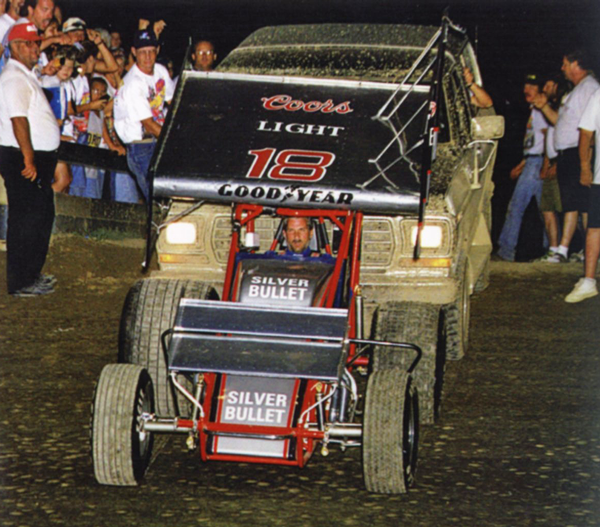 |
|
#3544 - On a magic night
Brad Doty, previously paralyzed in a grueling
Sprint Car crash, returned to Eldora to pace the
feature field of the 1998 King's Royal. (The car
had a Honda four-wheeler hand-throttle setup).
"As the truck pushed me away, everyone along the
pit lane was giving me the thumbs up. As I drove
around the track, people came to the fence and
were waving, pressing against the fencing as if
they were trying to touch me as I rolled by.
Although thousands of people were waving at me,
and maybe a million more were watching on
television, at that moment I was all alone. It
was me and the race car, alone on Eldora's steep
banks. As I went through turn two, my mind
flashed back 10 years to a night that shaped the
lives of many people. A night that took me
several years to fully deal with. In a way this
moment was the closure I had been looking for.
As that concrete wall swept past I felt a
renewed sense of purpose, a euphoria I thought I
had forgotten. For ten long years the dragon had
trailed me, trying to steal my hopes, my dreams,
my life. But now the dragon was dead, forever
silenced and out of my heart." (Caption and
Photo from
STILL WIDE OPEN, by Brad Doty with Dave
Argabright.) |
|
m |
|
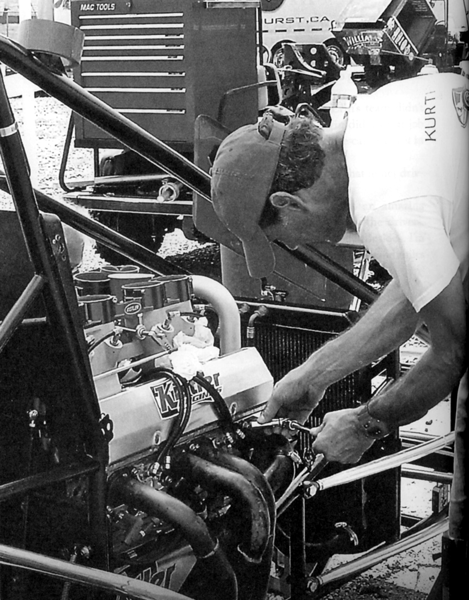 |
|
#3543 - That's Ray Evernham,
with his most careful touch, tuning recent bride
Erin Crocker's 410 at Knoxville in 2010. Later
that year, they both pulled into a 360 Sprint
Car race in North Carolina. He recalls, "t was
the only time Erin and I got to race together
which was really cool. Even cooler was Erin won
the race and I finished sixth. What wasn't so
cool was on the last lap Erin was lapping me as
she passed the start-finish line; she says she
was giving me extra room, and I say she was
waving at me. Either way, she hit the wall and
her car tumbled into the air and out of the
speedway. The racing headlines said 'Husband and
Wife Crash at Start-Finish Line. Wife Wins.' We
laugh about it now, but it wasn't very funny
then." (Photo and Caption from
RAY EVERNHAM: Trophies and Scars, by
Ray Evernham with Joe Garner) |
|
m |
|
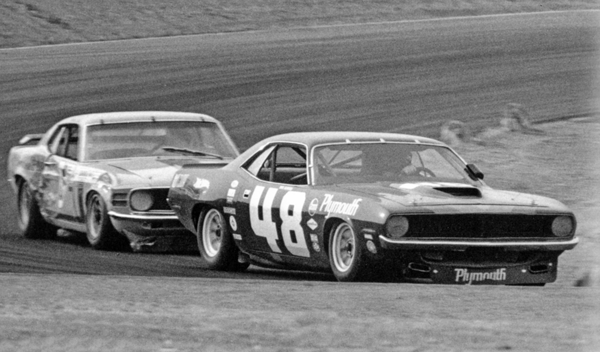 |
|
#3542 - Mission Bell 200
Trans-Am event, Riverside, 1970: "In a race
Parnelli Jones regards as 'my best drive ever,'
he clawed his way back through the field to
victory. Fans and drivers alike recall the
spectacular sight of Jones drifting through
Riverside’s famous esses, clipping apexes at
every turn, and intentionally striking the
curbing to bounce his Boss 302 onto its outside
wheels to turn it in for high-speed corners.
Here Jones (15) prepares to pass Gurney (48). It
was the last time either driver would race
against each other." From TRANS-AM: The
Golden Years in Photographs 1966-1972, by
Daniel Lipetz. |
|
m |
|
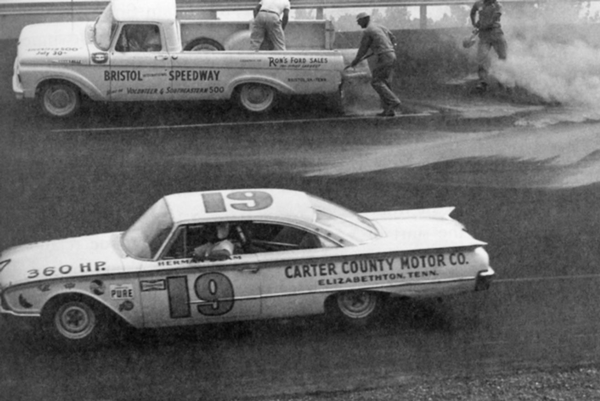 |
#3541 - Herman Beam was
another kind of smoke. The quiet engineer from
Johnson City, TN, earned the nickname "Turtle"
by going slowly in his early Grand National car.
He attracted considerable attention at the 1960
Daytona 500 when he was black-flagged after
eight laps for forgetting to don his helmet.
Then, from 1961 and 1963 he set a remarkable
record. He entered 86 races and finished every
one of them. It ended on March 17, 1963, when he
blew his clutch at the Atlanta 500. A
HISTORY OF EAST TENNESSEE AUTO RACING, by
David McGee. (Carl Moore Photo)
|
|
m |
|
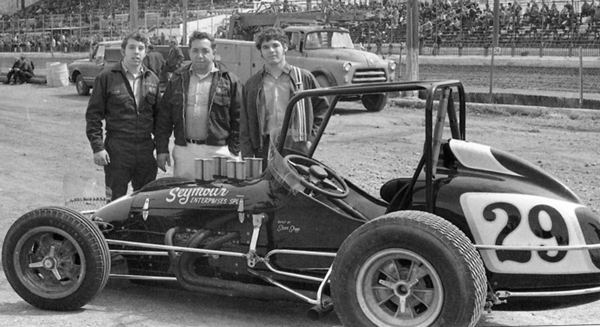 |
|
#3540 - "Boston Louie
Seymour towed Sprint Cars from his home in
Marlboro, MA, all over the country to compete in
what was then USAC's Thunder and Lightning
division. In one ten-year period he racked up a
million miles pulling those cars. But Boston,
(center) also competed in USAC's Silver Crown
Series, where in 1976 with his sons Mike (left),
Bobby (right) and driver Billy Cassella the
family won the championship. This photo was
taken at the final race of the series, Syracuse
in October, on the day they earned the title.
Caption from
A HISTORY OF AUTO RACING IN NEW ENGLAND: A
Project of the Northeast Racing Museum.
(Dick Berggren Photo). |
|
m |
|
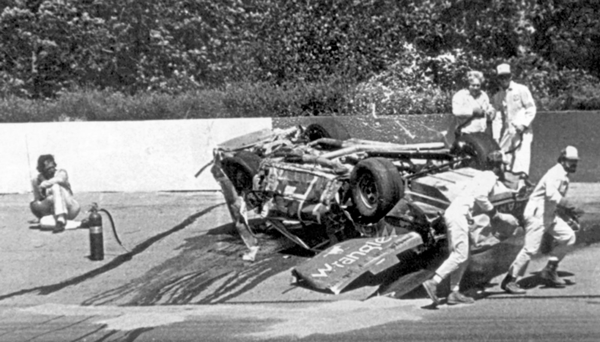 |
|
#3539 - Tough guy! "Dale Earnhardt
had a pretty hairy wreck in the Bud Moore
Wranglers Ford at Pocono in 1982. Tim Richmond
was also involved. Dale is sitting on the track,
off to the left." From
FLORIDA MOTORSPORTS RETROSPECTIVE PICTORIAL,
by Eddie Roche. (Roche Collection) |
|
m |
|
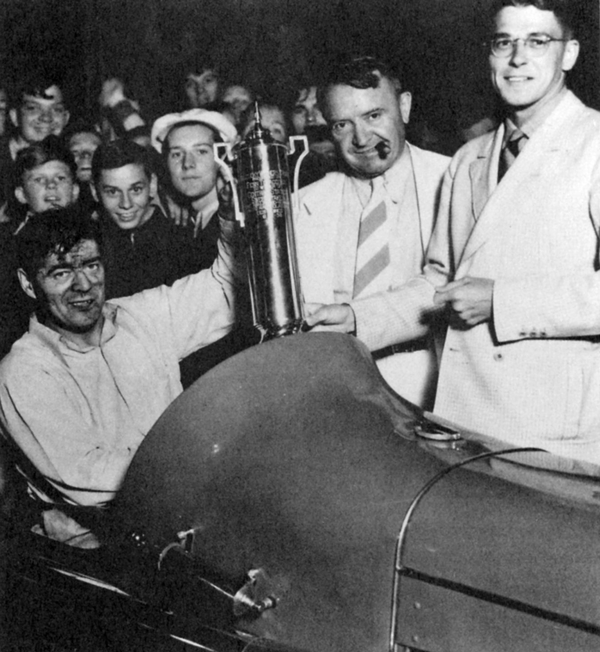 |
|
#3538 - On June 27, 1938, at
the Iowa State Fair, Emory Collins showed a bit
of wear sitting in his Offy/Miller Sprinter
after winning a battle royale with Gus Schrader.
Congratulating him in Victory Lane were Barney
Oldfield and announcer Ronald Reagan. From
SAFE AT ANY SPEED: The Great Double Career of
Joie Chitwood, by Jim Russell and Ed
Watson. |
|
m |
|
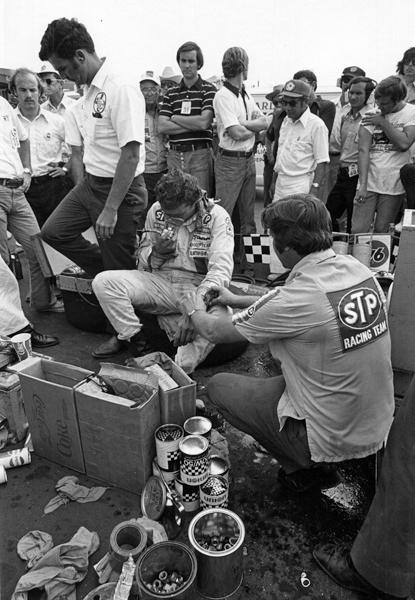 |
#3537 - In what might well
be the best of all his terrific books, Bones
Bourcier does a deep dive into the souls of
FOYT, ANDRETTI, and PETTY, America’s
Racing Trinity. He captions this image,
“Few drivers have ever played hurt as often as
NASCAR’s King.”
|
|
m |
|
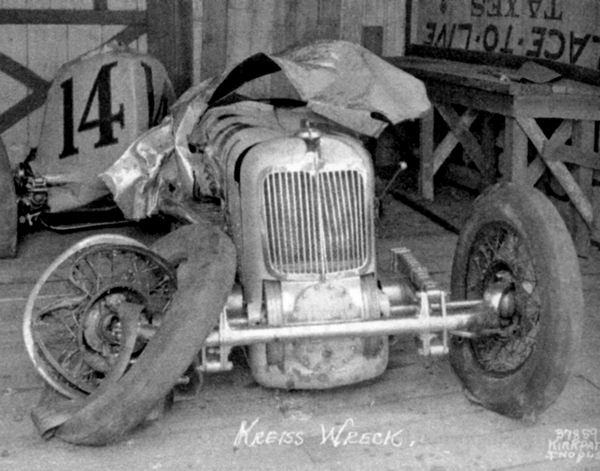 |
|
#3536 - In his rigorously
researched book
THE LAST LAP, author William Walker
investigates the deaths of driver Pete Kreis and
riding mechanic Bob Hahn at the Indy 500 in
1934. Considered to be one of the strangest
incidents in racing history, there were no skid
marks leading up to the wall, no signs
whatsoever of any kind of mechanical failure
after very thorough analysis. The whole issue
remains unresolved, with a dark, lingering
thought in the background - might this have been
a suicide? From
THE LAST LAP, by William Walker. (IMS
Photo) |
|
m |
|
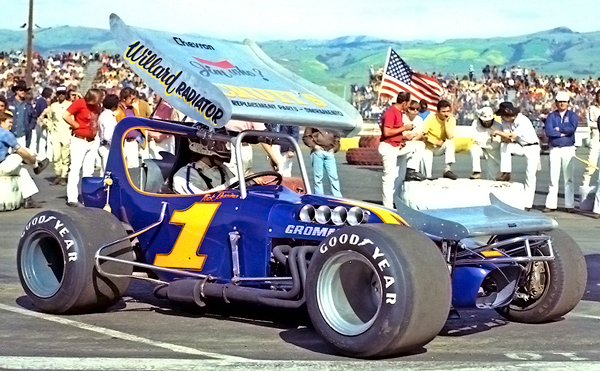 |
#3535 - "Quick Nick" Rescino
was unquestionably among California's greatest.
Shown here at San Jose Speedway in the mid-'70s
in an asphalt Super, he won with everything he
drove. Especially remarkable was when, wheeling
a Supermodified, he whupped the World of Outlaws
travelers at their own game. Over the years he
racked up over 200 fast times. (Dennis Mattish
Photo, from
Sea to Shining Sea, by Ken Clapp)
|
|
m |
|
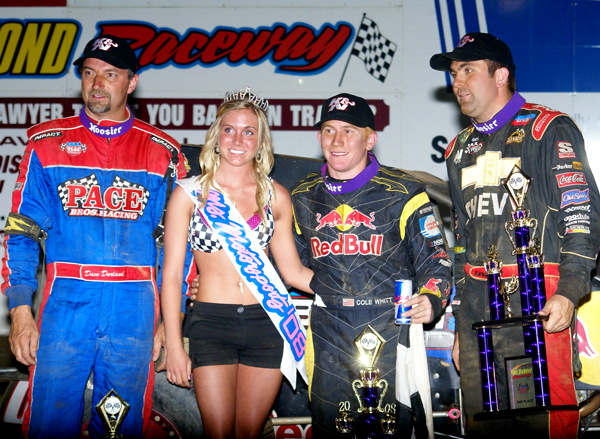 |
|
#3534 - San Diego's Cole
Whitt was in the karts when Team Red Bull took
notice of him, putting him in Sprinters in 2004.
He moved to Indiana, traveling the country with
his helmet. On June 8, 2008, he pulled into Big
Diamond Raceway in Minersville, Pennsylvania. As
pictured in victory lane at age 17 with Dave
Darland and Levi Jones, he knocked off the
feature, becoming one of USAC’s youngest
winners. He was on his way to NASCAR. (Mike
Feltenberger Photo) |
|
m |
|
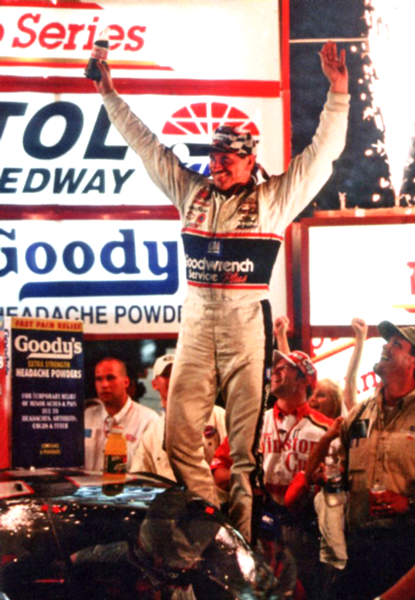 |
|
#3533 - It was 30 years ago, before
taking out the leader became
commonplace...."Dale Earnhardt celebrates in
Victory Lane after bumping Terry Labonte late in
the race to win the 1999 Goody's Headache Powder
500 at Bristol Motor Speedway. The move was
virtually a repeat of what Earnhardt had done to
"rattle his cage" and beat Labonte in the 1995
Goody's 500. Earnhardt was booed heartily by
fans in the stands for one of the few times in
his long NASCAR career." From
NASCAR 75 YEARS, by Kelly Crandall,
Jimmy Creed, Mike Hembre and Al Pearce. |
|
m |
|
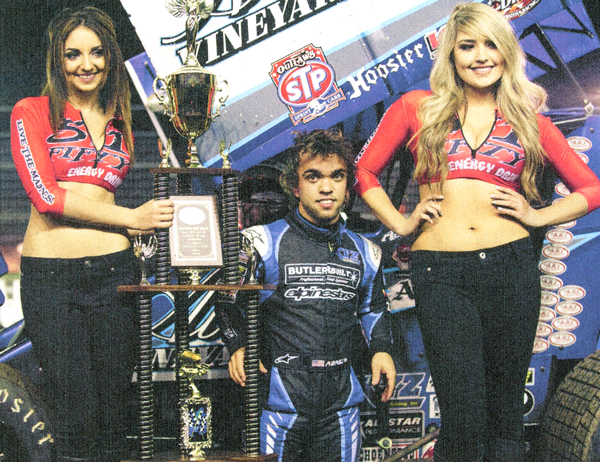 |
|
#3532 - It may have been ten
years ago, but he was red hot already. Rico
Abreu winning the inaugural Tribute to Gary
Patterson, a Civil War Series race at Stockton,
CA, in 2014. From GUIDE TO NORTHERN AND
CENTRAL CALIFORNOIA RACEWAYS, by Saroyan
Humphrey. (Humphrey Photo) |
|
m |
|
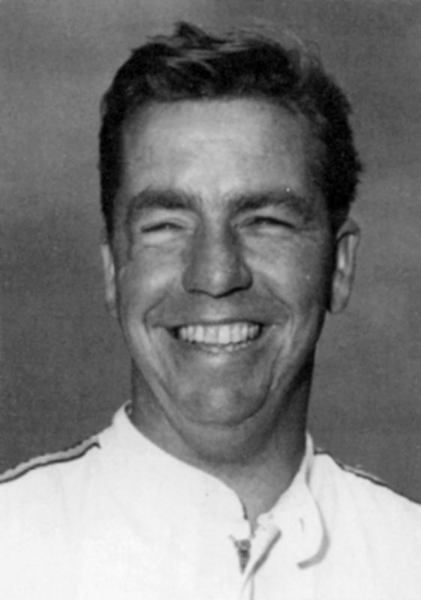 |
|
#3531 - On July 13, 1974,
NASCAR's Grand National West pulled into Eugene,
Oregon, for a 100-lapper on the 3.8-mile
pavement. Red hot Jack McCoy was fast qualifier
and swept the main. He recalls, "When you're
right, you're right....And we used an air
shock-a dummy with no valving but with the
inflatable feature in place to raise the rear of
the car to meet NASCAR's minimum roof-height
standard. After going through inspection, we
'adjusted' the relief valve that lets the air
out of the unit near the driver's seat,
restoring the ride height we desired. On this
hot evening I forgot to release the pressure on
my qualifying run, but still set fast time. Was
a crazy lap with all that weight jacked into the
car." From RACING"S REAL McCOY, by Jack
McCoy. (McCoy Collection) |
|
m |
|
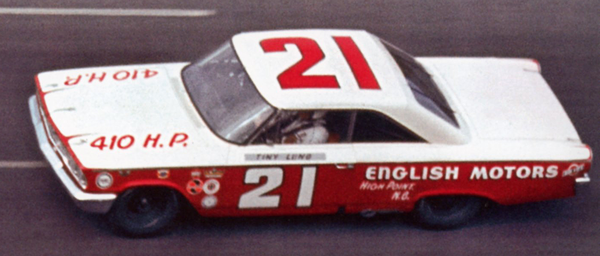 |
|
#3530 - Iowa native Tiny
Lund sure got it done fishing. He had a popular
freshwater camp down in the low country of South
Carolina, and he himself pulled in a 55-pound
striped bass, a recordholder for 30 years. But
with NASCAR Cup racing, he had but one
superspeedway win, the '63 Daytona 500 in the
Wood Bros #21. He was replacing their driver,
Marvin Panch, who had been burned earlier in the
week in a non-Cup event and Tiny had pulled him
out of the wreckage. Over the subsequent years
Tiny's real success came on the short tracks
where he won big time. Nonetheless, he did
decide to take a one-off Cup ride at Talladega
in 1975, getting into the show after first
alternate Grant Maddox dropped out. Tiny went
only six laps before a huge backstretch melee
claimed his life. He was 45, leaving his wife
Wanda and son Christopher. (Photo from NASCAR
The Complete History, by Greg Fielden) |
|
m |
|
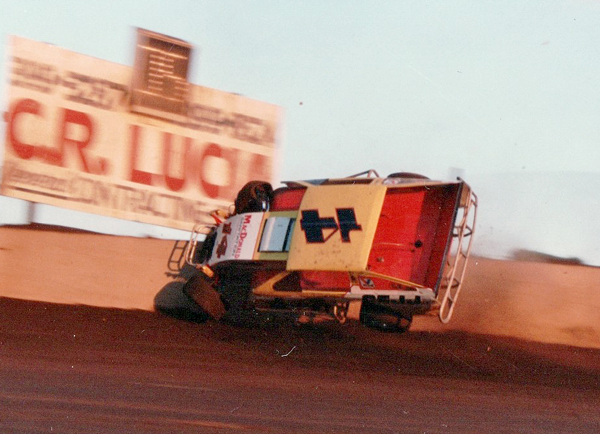 |
#3529 Gutsy Ricky Wright was a winning
Big Block Modified driver in the 1980s and '90s
at Lebanon Valley, New York. It's an
intimidating high-banked half mile, not a good
place to have brake problems...One night he was
hit hard from behind in traffic. The belly pan
beneath the driver folded up from the rear,
breaking Ricky's foot badly. As he was taken off
to the hospital, the medics wanted to prepare
him for arrival by cutting off his fire suit.
Painful though the injury may have been, the
loss of an expensive fire suit would be even
worse. He made them wrestle it off whatever the
consequence. Two years later, Ricky was riding a
motorcycle right next to the track and he
crashed. He hurt his leg again, this time really
dramatically, with a femur penetrating his blue
jeans. He made no complaints about any treatment
of his outerwear when the helicopter came to
take him for a ride. Maybe motorcycles are too
dangerous for Big Block Modified drivers." From
MODIFIEDS OF THE VALLEY: A History of Modified
Racing at Lebanon Valley Speedway, by
Lew Boyd. (Mark Brown Photo) |
|
m |
|
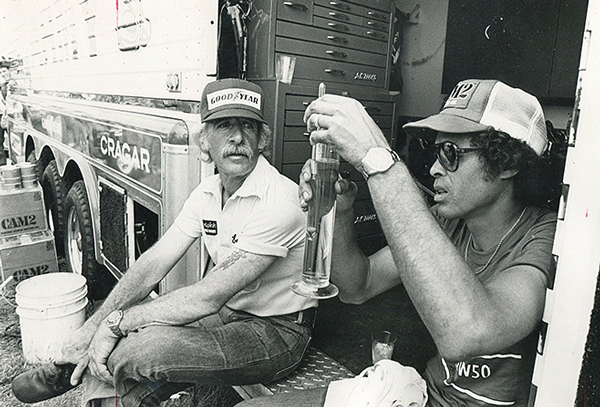 |
|
#3528 - Don "the Snake"
Prudhomme and Ed Pink occasionally clashed, but,
boy, did they win drag races. From
Ed Pink: The Old Master, by Ed Pink
with Bones Bourcier. (Ed Pink Collection) |
|
m |
|
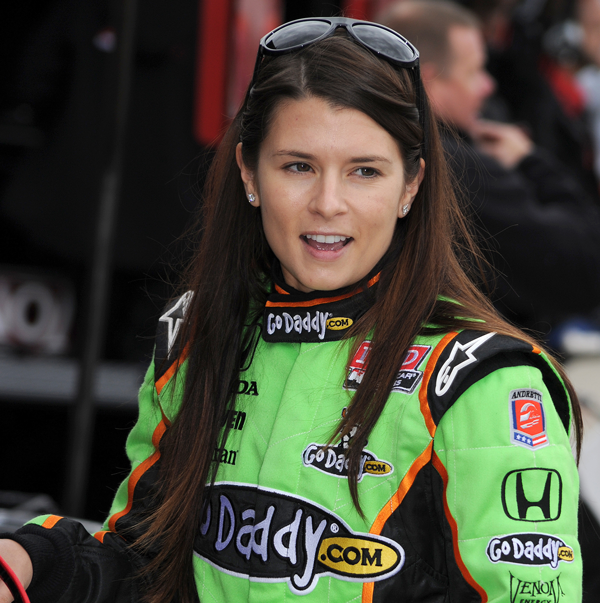 |
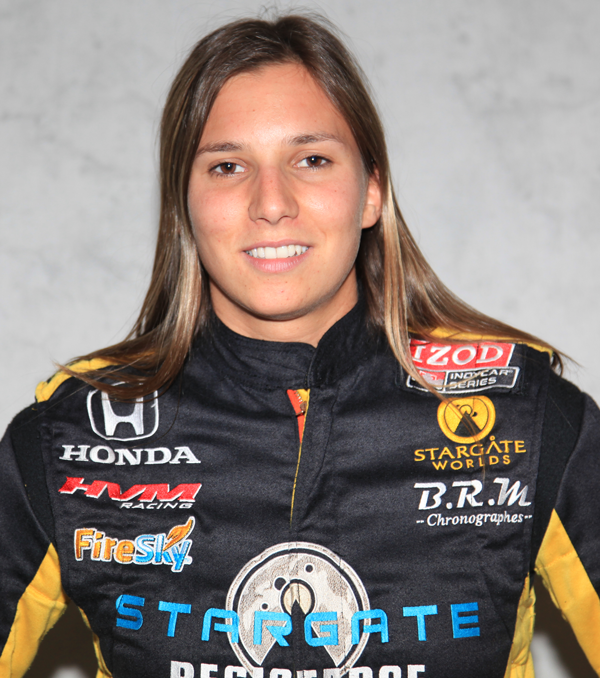 |
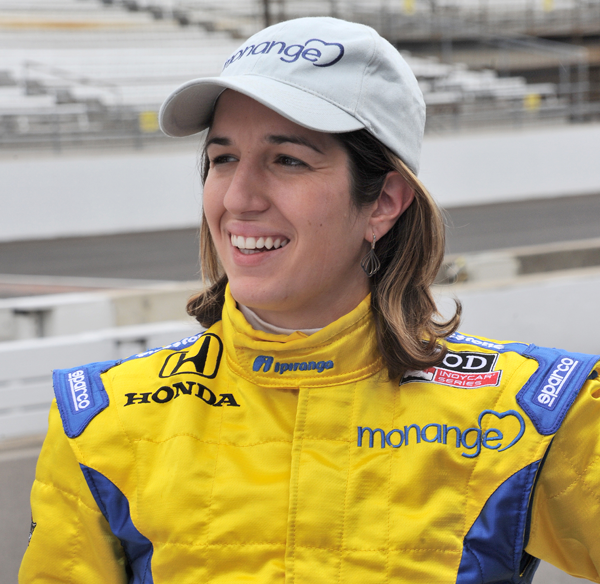 |
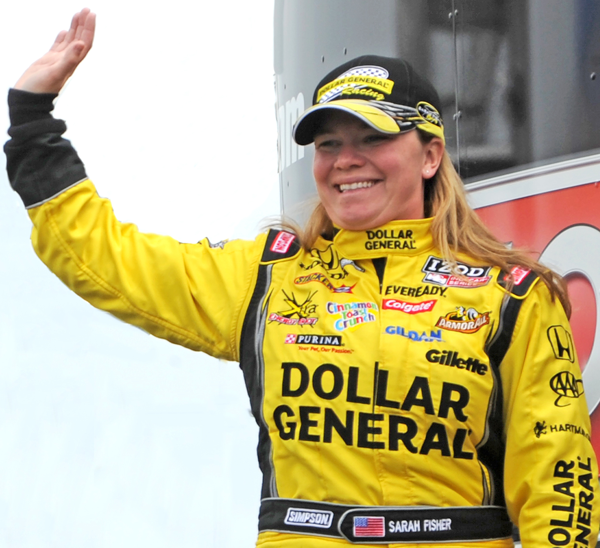 |
|
#3527 - In 2010 a record was
established as four women qualified for the
[Indy] 500. Danica Patrick (top) finished sixth
while Simona Silvestra (2nd) was 14th and
honored as the top rookie. Ana Beatriz (3rd) and
Sarah Fisher (bottom) were both eliminated in
accidents. Caption and photos from
500 on the (Indy) 500: Tales, Facts, and
Figures on the Greatest Race in the World,
by Rick Shaffer. (Simona, IMS Archive; balance,
Dan Boyd) |
|
mm |
|
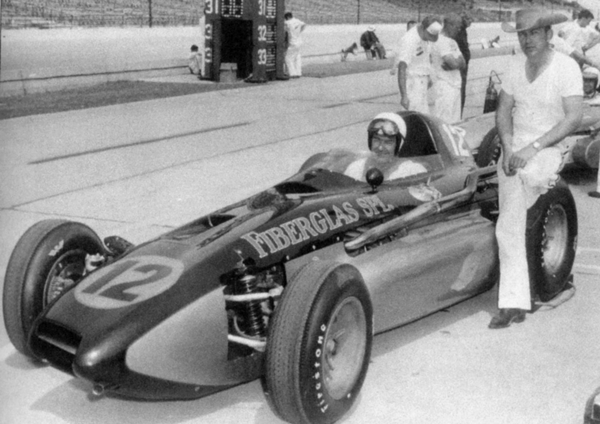 |
|
#3526 - In 1963 Curtis
Turner told Smokey Yunick that he was determined
to run at the Brickyard. Yunick dusted off a car
he called "the Python," and off they went. There
was just a wee bit of women-and-song out there
in Indiana, and with two days to go, Yunick
pointed out that they needed 3 mph more to even
qualify. So Turner went for it big time – and
got the third-turn wall. He subsequently
apologized and suggested they restart the party.
Yunick recalls that somehow, "We were in Vegas
two days later finishing that up, and I go back
to Daytona with the remains in about a week. I
think the Python was cremated. Its remains went
to Japan and came back as a Honda motorcycle
(probably two of them). We did extinguish any
burning desire Curtis had to conquer Indy." From
THE BEST DAMN GARAGE IN TOWN, by Smokey
Yunick. |
|
m |
|
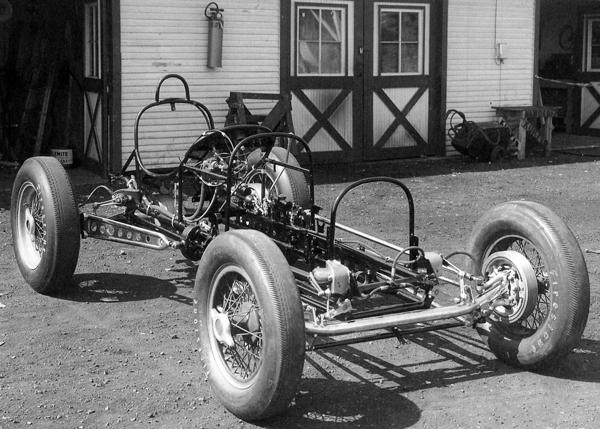 |
|
#3525 - With its twin
tubular-steel side members joined by perforated
webs, the Kurtis Kraft 2000 chassis was suitable
for both dirt tracks and the Indianapolis Motor
Speedway. It was sprung by torsion bars. From
INDY CARS OF THE 1950s, Ludvigsen
Library Series. |
|
m |
|
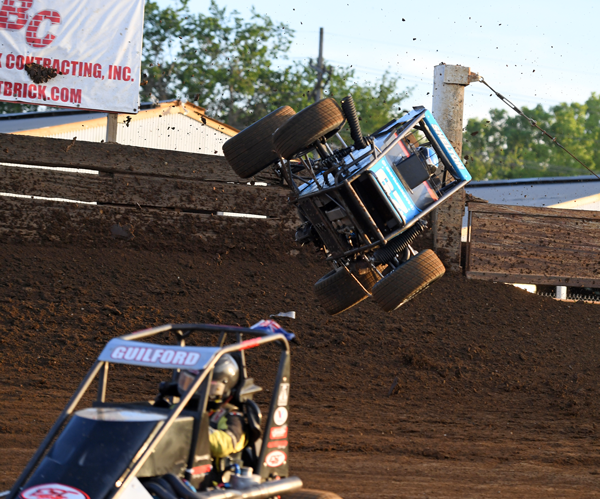 |
|
#3524 - While it first appears that
Holly Shelton has found a new way to pass POWRi
Midget Series competitor Max Guilford by flying
over the top of him, unfortunately for Holly,
it's the beginning of a series of flips in
between the first and second corners at the
Belle-Clair Speedway, Belleville, Illinois, in
2018 at a POWRi Lucas Oil National Midget League
event. Holly suffered no injuries. Unfortunately
Belle-Clair, a neat little track with that
distinctive wooden fence, closed a couple of
seasons back. (Photo and caption by Don Figler.) |
|
m |
|
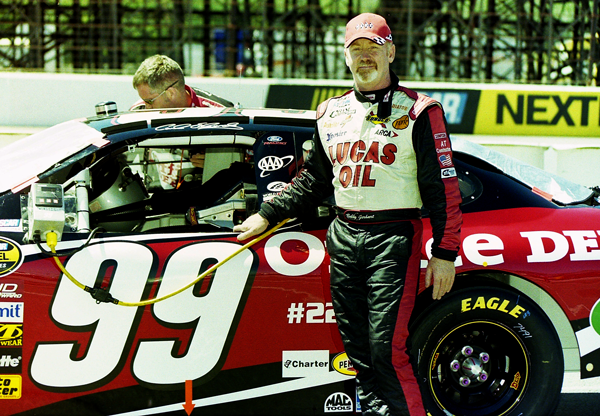 |
|
#3523 - Former dirt track
racer, ARCA star, multi-class NASCAR driver, and
race director at Penn National Speedway,
Lebanon, Pennsylvania's Bobby Gerhart Jr. was
tabbed to qualify the Roush Racing #99 at Pocono
in 2005 while regular driver Carl Edwards was in
Colorado running the Salute to the Troops 250 at
Pikes Peak International Speedway. Edwards
finished fourth after starting 41st in the
43-car field. (Mike Feltenberger Photo) |
|
m |
|
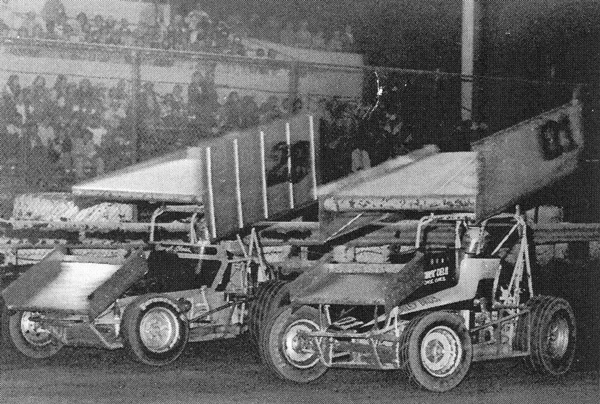 |
|
#3522 - The diminutive,
star-crossed Cheryl Glass (#28) races to the
outside of Lealand McSpadden at San Jose
Speedway in 1981. "It takes a lot of me to run a
night of practice, qualifying, heat races, and a
sprint car main event," sprint car driver Tim
Green said, "and I’m over six feet and 200
pounds. Then I look at this little, very
lady-like woman, who drives a lot faster and
smoother than some top male drivers, and I’m a
little lost for words." From
THE FIRST LADY OF DIRT: The Triumphs and Tragedy
of Racing Pioneer Cheryl Glass, by Bill
Poehler. (Shirley Glass Collection) |
|
m |
|
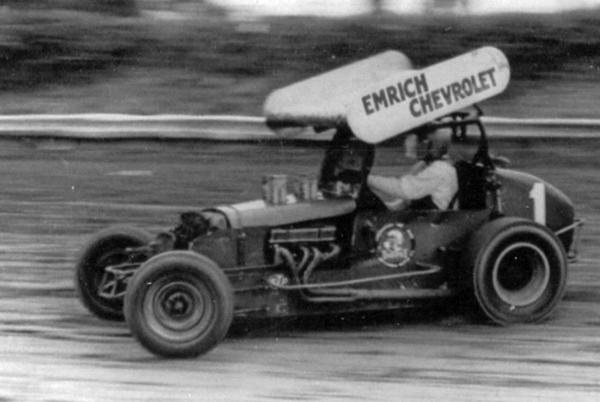 |
|
#3521 - In his brand new
book, Lynn Paxton recalls a memorable 1968, both
on the track with a new car as well as an
unexpected encounter at the concessions stand.
"This is 'the ‘Bathtub' at speed at the Grove,
October 6, 1968. The car brought sixteen feature
wins. Always at a disadvantage against the
high-priced, custom-built sprinters, the Kenny
Weld-built car with Paxton as the driver held
its own to say the least. It was a tough
machine, always taking abuse and coming back for
more. Paxton flipped it five times that year."
And then there was Barbara Deardorff. Barb's mom
would make the introduction happen at the
refreshment stand at Susquehanna where Barb was
working. Barb says, "I thought he was a real
geek." They married in 1972. From
LYNN PAXTON: My Way, by Don Robinson.
(Kings Photo) |
|
m |
|
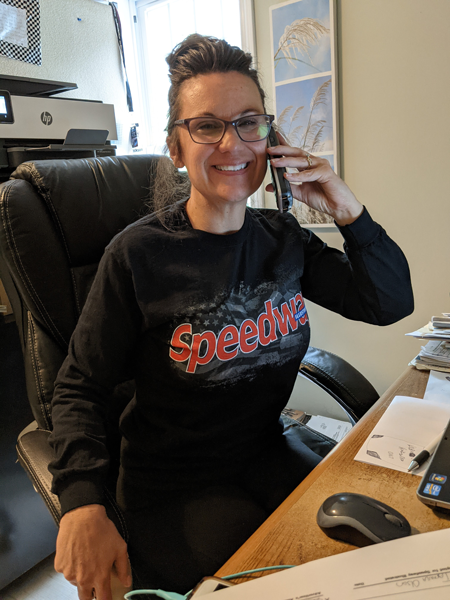 |
|
#3520 - She's the voice that
smiles when you call customer service at
Speedway Illustrated magazine. Christine
Worthington was also winner of the Eastern
Motorsports Press Association's President’s
award last month. She surely deserved it. She
helps keep the publication timely and lively,
with contributors countrywide focused on the
goal of helping folks race "Faster, Safer,
Wiser." But of all her talents, the one most
relied upon is keeping the ground wires tight on
her husband, Karl Fredrickson, the magazine's
highly charged founder and mayordomo. (Speedway
Illustrated Photo) |
|
m |
|
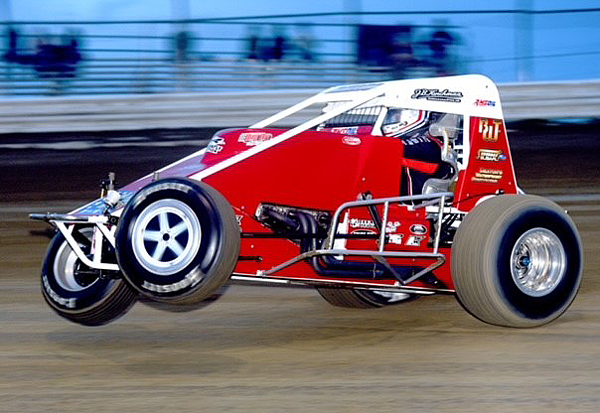 |
#3519 - Oh my! Robert Ballou
at Ocala on February 16, 2024. (Photo John
DaDalt, master lensman from the Nutmeg state)
|
|
m |
|
 |
|
#3518 - Even back when
racing, Jeff Gordon has passionately supported
pediatric-cancer research. Working with the
Clinton Global Initiative and Paul Farmer's
Partners in Health, he's supported the Butaro
Cancer Center of Excellence in Rwanda. He is
shown with his wife, Ingrid, visiting with kids
near the Center. From
JEFF GORDON: HIs Dream, Drive, & Destiny,
by Joe Garner |
|
m |
|
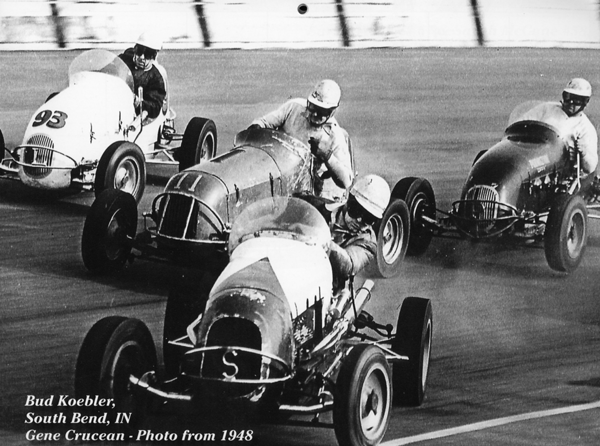 |
#3517 Check out the faces. From Don
Figler's
MIDGET RACING CALENDAR 2024.
|
|
m |
|
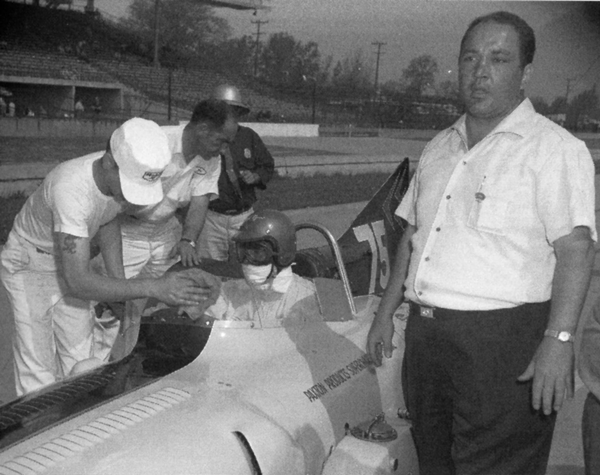 |
|
#3516 - Gutsy Ralph Liguori
in Andy Granatelli's Novi at Indy in 1961,
prepping for some practice. After a few
refresher laps, Ralph went to pick up some
speed, and the engine exploded, distributing
hundreds of parts and pieces with the car
sliding down the backstretch and pounding the
wall. With blood-soaked gauze on his face and
neck from burns, he hopped off his cot in the
infield care center and announced he was ready
to go again. But he never had the chance to try
to qualify, losing his shot at a front-row start
and possible track record, He lamented, "That
was a low point in my career because I thought I
had it made." Quote and Photo from
RACERS IN THE SUN: The Story of Florida's Sprint
Car Legends, by Richard Golardi. (IMS
Photo) |
|
m |
|
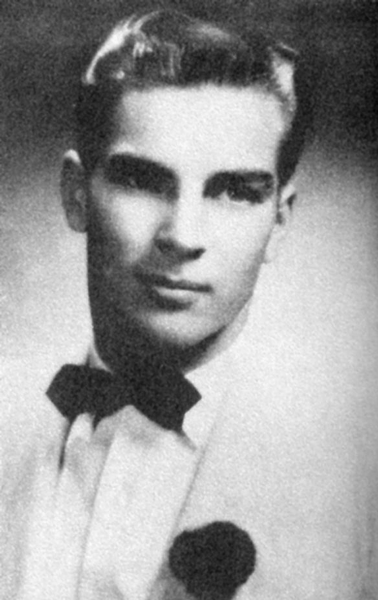 |
|
#3515 - A white sport coat and a
pink carnation. Who would have known this 1950s
high-schooler at graduation in the San Francisco
Bay area was already a professional motorcycle
racer performing on AMA.s half-and mile ovals on
the West Coast Flat Track circuit? His name was
Jan Opperman. From
Dialed In: The Jan Opperman Story, by
Jon Sawyer. (Opperman Collection) |
|
m |
|
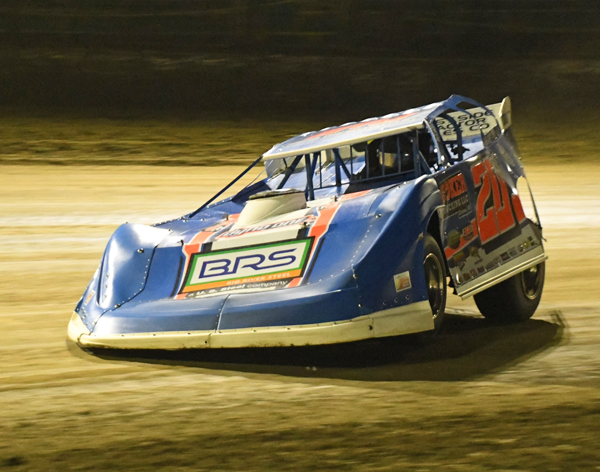 |
|
#3514 - World of Outlaw Late Models
are enormously popular and this photo shows why.
When the race looks as if fans could drive the
cars, it's not as good as when the cars look
really hard to drive. Outlaw Late Models are set
up to hike the left front wheel up in the
corners, while the left side of the car's rear
end moves forward 6-8 inches. Called "roll
steer," that shift forward of the left rear axle
has a lot to do with the incredible speed these
cars achieve in the dirt track's corners. This
photo was taken of Ricky Thornton at
Barberville, Florida's Volusia Speedway Park on
a night that preceded the 2024 Daytona 500.
Think you could drive wide open through a dirt
track corner in a car that's this out of shape?
(Caption and Photo by Dick Berggren) |
|
m |
|
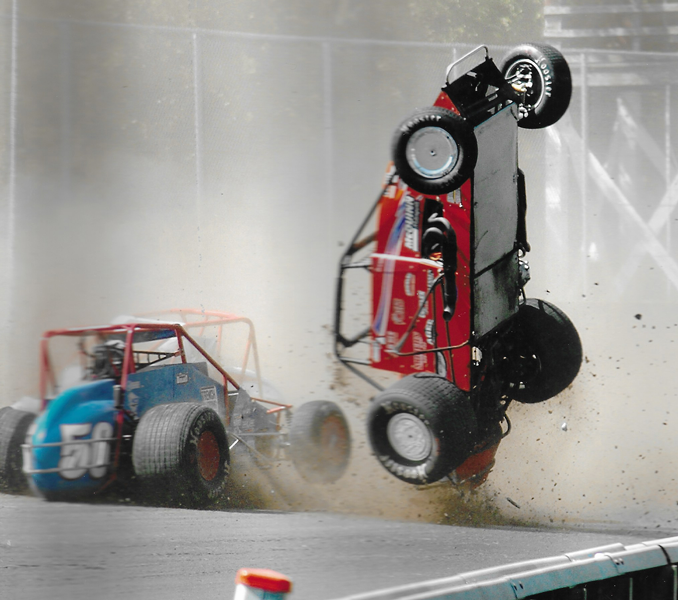 |
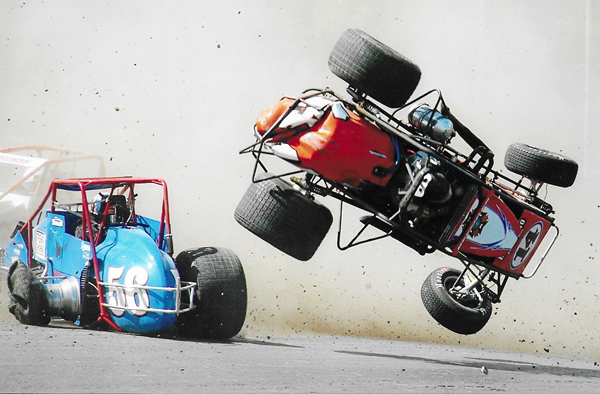 |
|
#3513 - Donnie Beechler #14
had a rough landing exiting the fourth turn
during the running of the Tony Bettenhausen
100-mile event in 2011 at the Springfield
Illinois State Fair. That's Dave Darland, #56
pointing in the wrong direction. Also involved
were Randy Bateman and Darren Hagar. No
injuries. Bryan Tyler won the race after
starting in the 14th position. (From our
photographer friend Don Figler) |
|
m |
|
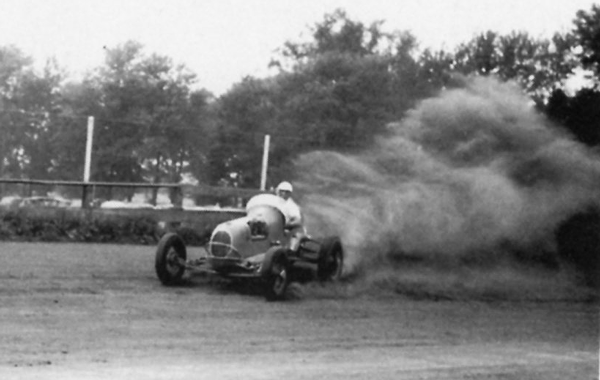 |
|
#3512 - "In 1942 leading
race sanctioning group, the American Automobile
Association (AAA), voted to wait until after the
war was over before they would sanction again.
To a degree the Central States Racing
Association (CSRA) bridged the gap. Joie
Chitwood edged out hot shots Tommy Hinnershitz
and Dave Randolph at Batavia, NY, just before a
national racing wartime ban was instituted on
August 1, 1942." From
DAREDEVILS OF THE FRONTIER, by Keith S.
Herbst. (EMMR Collection) |
|
m |
|
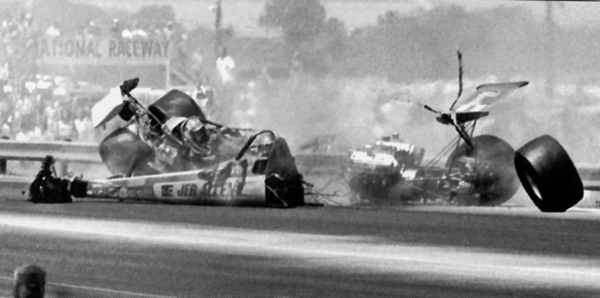 |
|
#3511 - In Tulsa in 1973,
"John Wiebe qualified number-one in the 32-car
Top Fuel field with a 6.119 ET at 229
mph...Wiebe's weekend came to a quick end, as
did that of 17th-qualifier Jeb Allen when the
pair tangled in the first round. Wiebe's Ed
Mabry-chassis car shook bad and took a hard turn
into Allen, destroying both cars. Allen received
burns in his face and hands, while Wiebe
suffered a broken leg and ankle after riding the
guardrail.” From
DRAG RACING'S REBELS: How the AHRA Changed
Quarter-mile Competition, by Doug
Boyce. (Don Gillespie Photo) |
|
m |
|
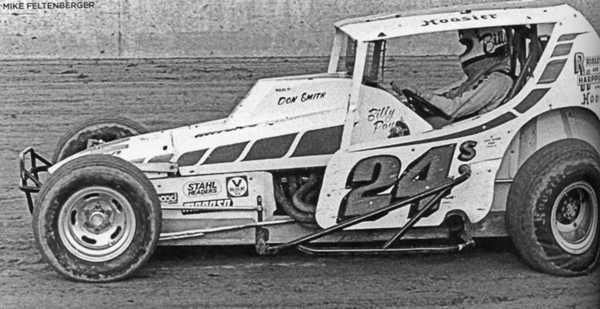 |
|
#3510 - In 1981 Billy Pauch
did something a little different. He accepted a
ride up north on Friday nights, running the
Ripley and Harbinger #24S Modified at
Albany-Saratoga. He recalls, "We were running
against Jack Johnson, C.D., Dave Lape, Chuck
Ely, Butch Jelley - it was a pretty good field
there. I drove all year for the 24S guys and
never won a race for them. But it was still a
good memory. That was a lot of fun. Get up there
to race, then go to the bars - they didn't close
until four in the morning. Sleep 'til noon. Then
stagger back to Flemington and win about ten
straight." From
THE LAST COWBOY: The Life and Times of Billy
Pauch, by Buffy Swanson. (Mike
Feltenberger Photo) |
|
m |
|
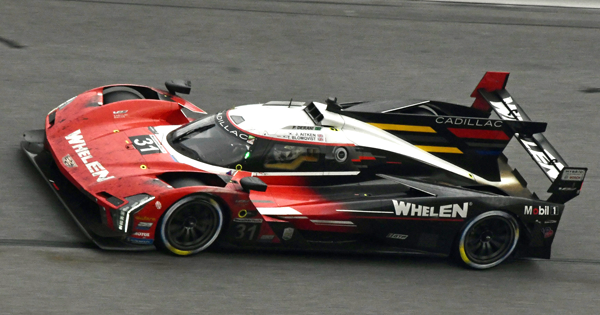 |
#3509 - On January 27 and
28, 2024, the 62nd Rolex 24-hour race ran at the
Daytona International Speedway 3.56-mile road
course. Four divisions, each running together on
the track at the same time, produced profoundly
varied speeds, some over 200 MPH, and
heart-pounding closing rates. The top divisions
were as exotic as today's Indy cars. Cars had
three or four drivers that shuffled in and out
of the driver's seat during pit stops. The
infield area not used for racing was filled with
fans who visited the many displays (including
historic Rolex cars) and rode on the full-size
Ferris wheel. Most tickets allowed access to the
stadium seats, fan zone and the garage. At the
end, two cars in the top division were within
one second of each other after 24-hours. The
Roger Penske Porsche won with drivers (Indy 500
winner) Josef Newgarden, Felipe Nasr, Matt
Campbell and Dane Cameron. The Whelen
Engineering Cadillac shown here finished second.
(Photo and caption by Dick Berggren)
|
|
m |
|
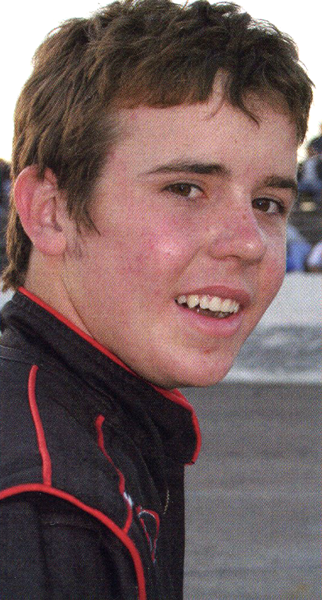 |
|
#3508 - The kids were
coming. Sixteen winters back, USAC Sprint Car
Rookie of the Year, Chad Boat, age 16, waltzed
the Billy Boat #30 to the youngest-ever race win
at Hagerstown, MD. From
MODERN THUNDER: The Illustrated History of USAC
National Sprint Car Racing 1981-2019,
by Dave Argabright, John Mahoney, Patrick
Sullivan. (John Mahoney Photo) |
|
m |
|
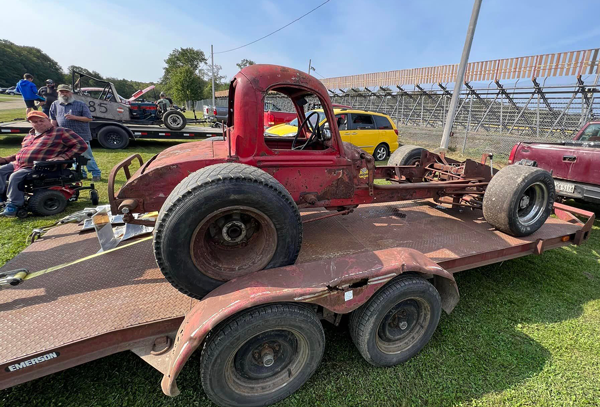 |
|
#3507 - When Maine's Unity
Raceway was reopened recently, it was met with
great enthusiasm. Lots of fans showed up,
especially when the SCONE Sprint cars were in
town. At the same time some neat stuff appeared
from out of the woods – and the past. How about
this '40s truck cab on a narrowed truck frame
from the early '60s? The Cutdown era had to be
one of the coolest and most creative eras in
American oval-track racing. In Maine, they ran
at places like Unity, Exeter, Ellsworth, and
Cherryfield before being largely replaced by
Late Models. This one was driven by Keith
Fuller, up-and-coming when he was killed in a
highway crash in 1968. (Unity Raceway Photo) |
|
m |
|
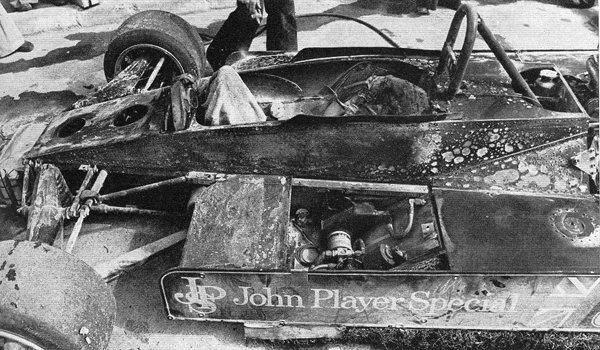 |
|
#3506 - Wow. Practicing for
the 1977 Gran Premio de la Argentina, Mario
Andretti was rocketing by the pit area at 160mph
in his Lotus when the fire bottle exploded. His
visor was covered with oil, but he managed to
ease it through an approaching turn and pull
off. The car was a mess. Mario suffered only
some bruising when the front bulkhead was blown
back. From AUTOCOURSE 1977-78, Mike
Kettlewell Editor |
|
m |
|
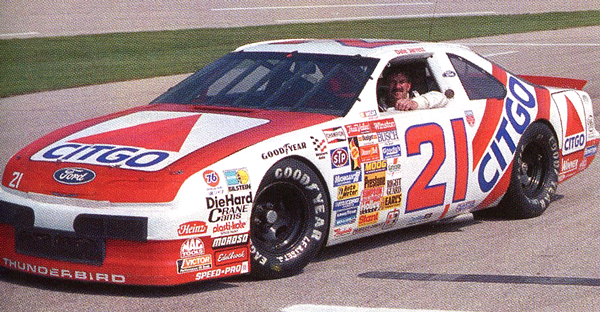 |
|
#3505 - It was 1990. "The
Wood Brothers #21 Ford sits on pit road during
the spring Talladega race week with Dale Jarrett
at the wheel. Neil Bonnett, who had to give up
the ride when he was injured at Darlington in
April, made his trackside return to Talladega.
Greeting him was Bobby Allison, who suffered
near-fatal head injuries two years earlier.
Bonnett broke the ice in the press conference
when he described his first conversation with
Allison, 'Me and Bobby were sitting there on the
couch,' said Bonnett. 'Between Bobby trying to
say what he was thinking and me trying to
remember what he was saying, it was a helluva
conversation.' Bonnett then told reporters he
would not attempt to compete in NASCAR Winston
Cup racing again in 1990." Quote and photo from
NASCAR: The Complete History, by Greg
Fielden.
|
|
m |
|
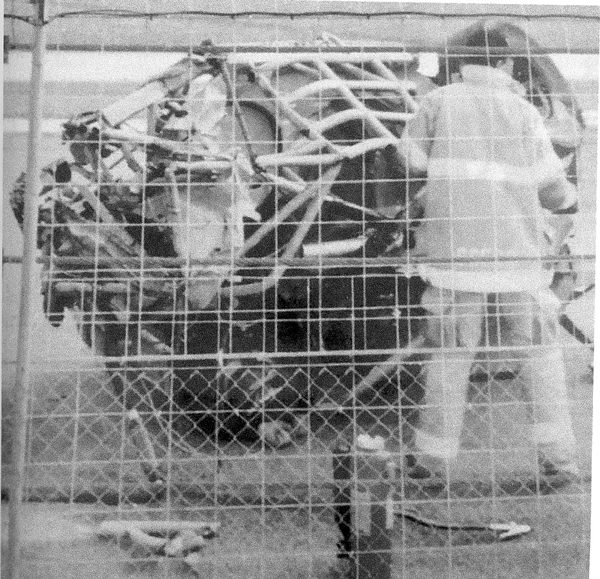 |
|
#3504 - Geoff Bodine posts this eerie photo of
the aftermath of his grisly Daytona truck crash in 2000. His caption
reads, "Look closely, and you’ll see God's angels protecting me."
From
ALL OF IT: Daytona 500 Champion Tells the Rest of the Story,
by Geoff Bodine and Dominic Aragon. (Bodine Collection) |
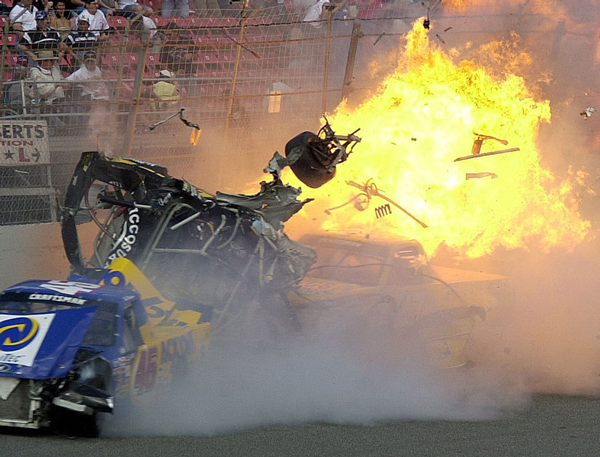 |
|
Our Webmaster, Norm Marx, was on the scene and his dramatic
photo shows the violence of the incident. (Norm Marx Photo) |
|
m |
|
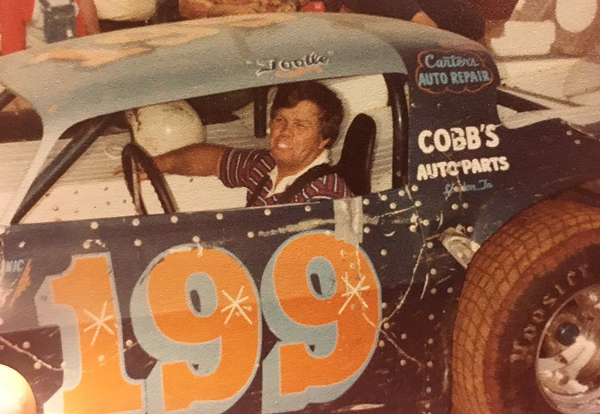 |
|
#3503 - Herbert Estes (nicknamed "Tootle" by an
aunt because he was too little to be a Herbert) was a terror in the
mountain of North Carolina, Northern Georgia, and Tennessee, whether
hauling 'shine or grabbing checkers. One season he reportedly won 85
of 104 features. Some say he compiled a career total of 1500. One
thing's for sure: He counted money not trophies. He won 17 in a row
at Greenwood, Speedway in South Carolina, receiving the same trophy
each week, promptly selling it back to the promoter. He passed away
of a heart attack in 1982, on his way home from Bull's Gap,
Tennessee, and a feature win at Volunteer Speedway. (Chris Corum
Collection) |
|
m |
|
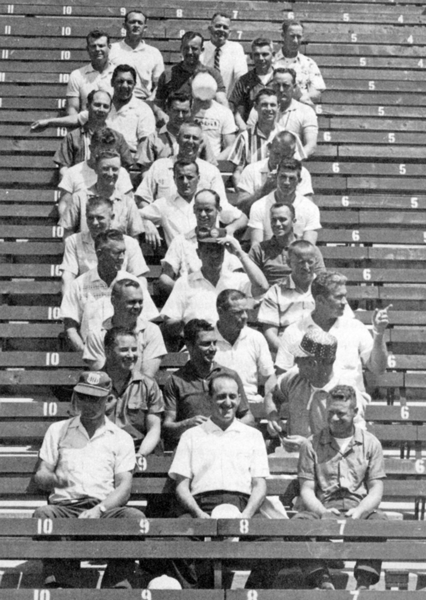 |
#3502 - Starting lineup: The Brickyard 1959.
From MY HERO, MY FRIEND: Jimmy Bryan, by Len Gasper and
Phil Sampaio. (Photo Courtesy IMS)
|
|
m |
|
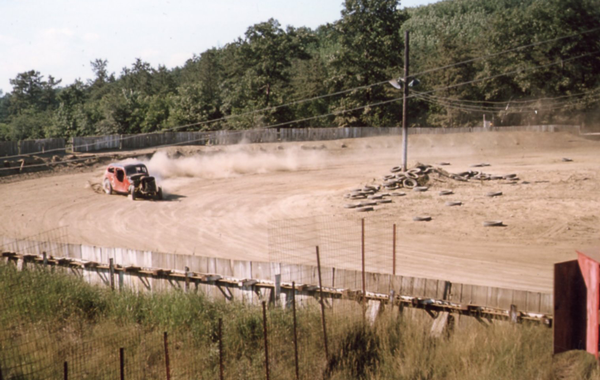 |
|
#3501 - Rhythm Inn Speedway in Millers Falls,
Massachusetts, was a high-funk 1/3-mile, one of the many that
operated for a short while in the 1950s. Rene Charland was track
champ in ’54 and ’55 and, like so many of his compatriots, he
responded to money, race cars and the ladies - in varying order. The
speedway was connected to a sister business, a club also curiously
named Rhythm Inn. That made for an inventive business model.
Charland often complained, "They'd pay you for the races and take it
all back at the barroom!" (Mike Ritter Collection) |
|
 Previous
Photos of the Day - PAGE 15 Previous
Photos of the Day - PAGE 15
 Previous
Photos of the Day - PAGE 14 Previous
Photos of the Day - PAGE 14
 Previous
Photos of the Day - PAGE 13 Previous
Photos of the Day - PAGE 13
 Previous
Photos of the Day - PAGE 12 Previous
Photos of the Day - PAGE 12
 Previous
Photos of the Day - PAGE 11 Previous
Photos of the Day - PAGE 11
 Previous
Photos of the Day - PAGE 10 Previous
Photos of the Day - PAGE 10
 Previous
Photos of the Day - PAGE 9 Previous
Photos of the Day - PAGE 9
 Previous
Photos of the Day - PAGE 8 Previous
Photos of the Day - PAGE 8
 Previous
Photos of the Day - PAGE 7 Previous
Photos of the Day - PAGE 7
 Previous
Photos of the Day - PAGE 6 Previous
Photos of the Day - PAGE 6
 Previous
Photos of the Day - PAGE 5 Previous
Photos of the Day - PAGE 5
 Previous
Photos of the Day - PAGE 4 Previous
Photos of the Day - PAGE 4
 Previous
Photos of the Day - PAGE 3 Previous
Photos of the Day - PAGE 3
 Previous
Photos of the Day - PAGE 2 Previous
Photos of the Day - PAGE 2
 Previous
Photos of the Day - PAGE 1 Previous
Photos of the Day - PAGE 1 |
|
|
|
|